Madison.
Ah, vacation. What better excuse is there to bore the pants off of friends and family with interminable slideshows of all your photos?1 So, in that spirit, here's a long, meandering account of our trip to Europe, complete with pictures (and, where appropriate, recipes).
Note: I've excised most of the crummy photos. Most.
To keep things from becoming unbearably long, I've divvied things up by location. This isn't a comprehensive account of our travels, but rather a highlights reel. Should you want to hear gripes about UK Immigration at Heathrow, or other less savory portions of the trip, you'll just have to ask in person.
Should you prefer the extended slideshow - complete with droning commentary2 - please feel free to come by. Bottle or two of wine in hand.
* * * * *
1My mother did tell me that, if we planned on showing her all six hundred photos, we'd better have a bottle of wine open and ready to go.
2This is the Parthenon. This is the Parthenon from another angle. And another yet. Et cetera.
18 April 2007
Europe 2007 - London.
Madison.
Sharon and I have both been to London before, have both seen all of the tourist sights we ever care to see, and had no deep-seated interest in spending piles of cash1 to kill time. Lazy walks suit us just fine, as does simply sitting about, chatting with friends, and cooking up a nice dinner. It was Melissa's birthday on 25 March, and I'd offered to cook up a nice meal to celebrate; if nothing else, it would keep me occupied while the Londoners were off at work during the day. We planned a dinner for six on Friday night, at Simon and Holly's place, where Sharon and I were staying.
We arrived in London at the crack of dawn on Thursday morning, with flurries all about the plane as we taxied to our gate. Neither Sharon nor I had slept particularly well on the flight over, so we didn't plan on doing much of anything that day. We met Melissa at her office, dropped off our luggage, and moseyed down to Borough Market to start the grocery shopping. The market recently started opening on Thursdays, which meant we could avoid the monstrous crowds of Friday and, even worse, Saturday, but only a quarter to a third of the stalls were occupied, so we didn't get the full experience.2
Borough is like a cross between a farmers' market and a grocery store. There were several butchers operating, a pair of fishmongers - one specializing in fish, the other in shellfish - a bakery, a cheese affineur, and several produce vendors, but there weren't any farmers selling local produce. Sure, it was late March, and it's hard to expect much produce then, even in the mild UK climate, but I'd hoped for something better. It was, in essence, just a grocery store with good-quality ingredients. Interesting, yes, and with plenty of good foods - meats, especially - to recommend it. But expensive, especially when it's difficult to see why lemons sold there should be any different from those sold in any grocery store.
It made me long for the purple "Local" tags that the Willy Street Co-op is so good about using.
But enough of that. We did pick up some fine ingredients, including wild mushrooms, pheasant, French raw milk cheeses, some wild boar sausages, and so on. The remaining odds and ends for dinner - flour, sugar, yeast, coconut milk, etc. - were easy enough to pick up at the Sainsbury's close to Simon and Holly's. Dinner, which had been roughly sketched out prior to our departure, had finally taken shape. I cooked all day Friday3 to prepare six courses for six, though we only had five4 at the table.
The menu was as follows:
Given all that, it turned out surprisingly well. Note that the lighting in the dining room was quite low, and I didn't have a tripod, so the picture quality's a little, uh, poor.6 Dish by dish, here's how it came together:

Chinese spoon with ginger-lime coconut milk pudding, candied ginger, and Thai-spiced peanuts
No sense fooling about; the first course - just a little amuse-bouche - ought to be exciting. I'd come up with this idea after reading about puddings in the New York Times, and figured that coconut milk would bring a lot of flavor on its own. It's very rich, given that it's loaded with fat, so a bite or two really did the trick. It's just a range of the flavors I normally associate with Thai food, ramped up in intensity.
For an even more interesting version, I'd recommend trying this with palm sugar, and adding a dash of fish sauce or shrimp paste; a southeast Asian hot sauce could only be a good thing, as well. I used Penzeys' Bangkok Blend to season the peanuts, and you could certainly use more of that for more flavor. Just toss the chopped peanuts with a generous sprinkle of seasoning, using a few drops of oil, if necessary, to make sure it sticks.
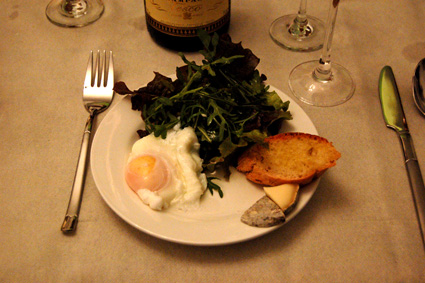
Salad of Lollo Rosso lettuce and arugula with orange-white wine vinaigrette, poached egg, crouton, and raw milk goat cheese
Sharon was an immense help here - and throughout the preparation and meal, I should add - preparing the greens while I poached eggs and toasted croutons. Between courses, I would return to the kitchen to cook the next, while Sharon cleaned any dishes we would need to reuse and offered a second set of hands. So, lest anyone think I can pull all of this off all by myself, take note.
There's nothing extraordinary about a salad, but the greens - reds, in the case of the lettuce - looked good, and more vegetables are always a good thing. And as I was looking for six courses that were impressive, but didn't require inordinate amounts of last-minute work, a salad was ideal. The original plan for the croutons had been to melt a little English cheddar on top until bubbling and brown, but the little cheeses we found at Borough Market were just too delicious. I didn't think that I could melt them and keep the qualities that made them so good, so I simply sliced and served alongside.
I'd also like to note: I took all of the least-pretty plates for myself. Thus this picture is the one ugly-looking poached egg of the bunch.

Seared and roasted pheasant breast with sauteed onion and wild mushrooms, orange-thyme spätzle, and black tea broth infused with star anise and blood orange
The original menu called for slices of duck breast with this dish, but we could only find them in pairs, meaning that there would have been far more meat than the modest little dumpling accompaniment I had in mind. Instead, we picked up a whole pheasant, and I removed the breasts for dinner. The legs, meanwhile, became the "staff lunch" for Sharon and I.
This dish was built around the idea of using tea somewhere in the meal. I toyed with it at home, and was pleased enough to run with it. It's a little unusual, and the broth was barely more than a sauce for the dish, but I like the way it works. It's also fun to pour the broth at the table; if I were at home, I'd use one of our cast-iron Japanese teapots, for a little style.
The spätzle, in this case, were good-sized dumplings, dropped off a spoon, but still remained rather delicate - moreso than the cheese gnocchi I'd also considered making. I was thrown for a loop when I couldn't find baking powder in the kitchen; a quick, fingers-crossed substitution of baking soda and freshly-squeezed orange juice managed to take care of things. It didn't, in the end, make a significant flavor difference, at least against the orange in the broth.
British mushrooms, which are a regular part of the typical British breakfast, are, I think, one of the numerous reasons the rest of the world makes fun of their cuisine. Sauteed just a little, they manage to find an odd middle ground between the firm texture of raw mushrooms and the soft texture and intensified flavor of fully sauteed ones. The texture's just a little firmer and spongier than canned mushrooms; they're wet with escaping moisture; and the flavor is raw mushroom without the freshness. Personally, I want some Maillard brown on there, with all that excess moisture cooked away to leave nothing but rich mushroom flavor. It didn't hurt that we picked up a nice range of wild mushrooms at the market - shiitake, two types of oysters, bluefoots, and chanterelles; the enoki, fairy rings, and porcini were tempting, too - and that they cooked with coarsely chopped onions until everything was browning and on the verge of crisping at the edges.
The pheasant I simply salted and seared, skin on, as best I could over high heat, then finished in a hot oven. I kept a hint of rosiness, just as I would for a duck breast. Sliced thinly, these laid across the top, to be drizzled with broth at the table.
The broth began with hot water and tea bags - three bags per two cups of water. Immediately, I added two whole star anise, the zest of an orange in big chunks, and let the whole thing steep, removing the tea bags after a few minutes. The star anise and orange lingered about for half an hour or so. Removing them, I added salt and the juice of the orange to taste, and thickened it with a little cornstarch. If you're feeling British, you could also thicken it with some cream, but I prefer the slight bitterness left in when it's not bound to milk proteins.
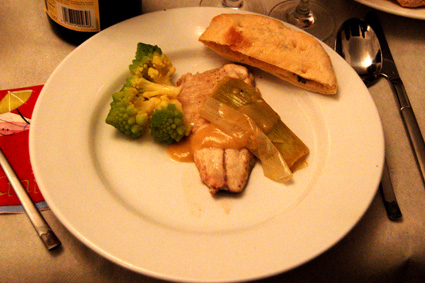
Poached sea bass fillet with braised leeks, romanesco broccoli, and thyme flatbreads
Braised leeks are easy, if messy. I'm used to relatively short leeks here, but the ones we found at the market in London were enormous batons. When possible, I'd recommend slicing the leeks in half along their lengths, in order to clean out any dirt, leaving the root end as close to intact as possible. This helps keep the various layers from drifting about in the braise. All you need to do is brown them well on both sides - cut side and, uh, the opposite - and simmer in liquid. In this case, it was a fish stock made from the heads and bones after removing the fillets. It takes about twenty minutes, and can be done ahead of time, if you'd prefer to simply rewarm the leeks in the liquid just before serving.
The fish poached in the liquid after removing the leeks, taking just a few minutes until the flesh went opaque and a knife slipped through without resistance. If there had been room, I'd've cooked the broccoli in there, as well, but I ended up cooking that in the leftover fish stock. Oven-roasting, just until the tips start to brown, would be another excellent preparation for broccoli.
If I'd had time, I would have made a real loaf of bread, but flatbreads taste almost as good and are remarkably easy. In fact, it's a general technique that I first started using while I was studying at Leeds, and continued with when Melissa and I shared a townhouse in college. When you would shape loaves from the dough, and allow for another rise as the oven warmed, you instead crank the oven to 450°F or higher. By hand or with a rolling pin, form general round shapes, thin like pizza crusts, and toss in the oven. A pizza stone works well, but simply laying them across the oven racks is fine. When they've puffed up and begun browning at the edges, they're ready. If you like a softer, more tender bread, err on the shorter side; if you like crisp, let them go a little longer. Do beware of steam escaping as they deflate - tongs are your friend.

Phyllo rolls filled with roasted eggplant, roasted garlic, and basil, with coarse sweet pepper and garlic zhug
This was the one course that had nothing planned beforehand, except that I wanted either little packages or something crispy. At first, I'd thought that I could use wonton skins to make potstickers, but we couldn't find anything even close at the supermarket. Then, Sharon had the brilliant idea for phyllo, and it was perfect.
Roasting the eggplant and garlic produced some soft sweetness, paired with some fresh basil, which I just rolled up in the phyllo, not even bothering to close off the ends. Brushed with a little olive oil, they went in the oven until the edges were brown and crispy. Sliced diagonally, they stacked up nicely on the plate, topped with a little zhug.
Not that it was a real zhug, but I like the name. This was a roasted red pepper, skin removed, diced into small pieces, to which I added minced raw garlic, salt, pepper and olive oil. It was fresh and sharp, from the garlic, in contrast to the sweetness in the rolls, and the bright red looked quite good against the brown phyllo and white plates. If I'd remembered to add a little chiffonade of fresh basil, it would have looked even better.
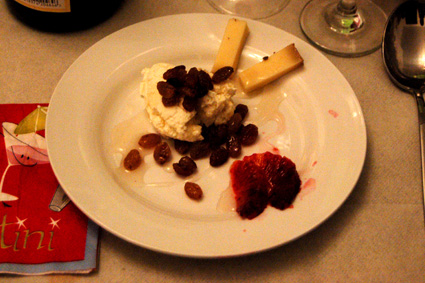
Fresh whole-milk ricotta with raw milk cheese, blood orange segments, wine plumped-raisins, and white wine syrup
When cooking in a new place, it's best to plan for unusual situations and, when possible, bring along all of the less-common things that you might need. Thus, I'd made sure to pack an instant-read thermometer,7 tongs, a microplane grater, and a few spices that I wasn't confident I'd find easily. Cheesecloth, silly me, I thought wouldn't be a problem.
When I asked Melissa where I might look to find some, on the off chance the grocery store didn't have any, she looked at me as though I'd asked where I might find fresh dinosaur eggs.8 Fortunately, she managed to come up with some cheap cotton dishtowels that did the trick, which was a real bonus, since I wasn't looking forward to using one of my t-shirts. That was my backup plan, but definitely a less than ideal one.
Early in the day, I created a simple syrup with equal parts white wine and sugar, and added in a fistful of raisins or two to plump up, bringing it just to a boil and then letting it all steep. Before serving, I took out the raisins and boiled the syrup until it ran off the spoon on a thick stream. The cheese was strained just before dinner, and simply salted.
To serve, I put a big spoonful of cheese on each plate, topped with some of the plumped raisins and a drizzle of the syrup. On the side were some cut segments of blood orange and another interesting cheese from Borough Market. I can't recall the name, but it was made from raw cow's milk, and not unlike the Bandaged Cheddar from Bleu Mont Dairy. I don't know that it necessarily went with the rest of dessert, but I liked it - and didn't want to go to the trouble of creating a full cheese course.
I then polished off the rest of the cheese as we sat around afterwards, finishing the last of the wine and digesting a bit before sleep.
* * * * *
1Prices in the UK are generally high, with a few exceptions. (Breakfast cereal comes to mind.) Add London-level premiums to that - much like spending more in New York City or Chicago for something that can be had more cheaply here in Madison. And then top it off with a spectacularly awful exchange rate.
2Sorry, but I didn't take pictures. Between juggling bags of meats and produce, jet lag, and low light levels, I didn't have the wherewithal to get going on that.
3After sleeping in, that is. Sharon and I hit up the grocery store first, and then I started cooking around 12:30pm, with dinner at 7-ish.
4James wasn't able to be there, as he was retrieving the houseboat he and Melissa had purchased, making the long, stomach-churning trip across the North Sea from the Netherlands. (More on that in the other London post.) So we saved him a little of everything, carefully packed for his triumphant return.
5In other words, getting good sear is nigh impossible, and pans can't go from the stove into the oven. These are issues that one can work around, but that take a little more stop-pause-think effort on my part.
6I refuse to use a flash unless absolutely necessary; I hate the flash about as much as I hate posed pictures. I feel that a flash flattens the image, eliminating texture and visual interest; posed pictures generally look fake to me, especially those with forced smiles.
7Why this isn't the sort of thing everyone has in a kitchen - I've got four or five, not counting chocolate and candy thermometers - is beyond me. Tongs, thermometers, and cast-iron cookware should be required equipment for everyone.
8Triceratops, preferably, but I'm not all that picky. Anything from the late Cretaceous would be just dandy.
Sharon and I have both been to London before, have both seen all of the tourist sights we ever care to see, and had no deep-seated interest in spending piles of cash1 to kill time. Lazy walks suit us just fine, as does simply sitting about, chatting with friends, and cooking up a nice dinner. It was Melissa's birthday on 25 March, and I'd offered to cook up a nice meal to celebrate; if nothing else, it would keep me occupied while the Londoners were off at work during the day. We planned a dinner for six on Friday night, at Simon and Holly's place, where Sharon and I were staying.
We arrived in London at the crack of dawn on Thursday morning, with flurries all about the plane as we taxied to our gate. Neither Sharon nor I had slept particularly well on the flight over, so we didn't plan on doing much of anything that day. We met Melissa at her office, dropped off our luggage, and moseyed down to Borough Market to start the grocery shopping. The market recently started opening on Thursdays, which meant we could avoid the monstrous crowds of Friday and, even worse, Saturday, but only a quarter to a third of the stalls were occupied, so we didn't get the full experience.2
Borough is like a cross between a farmers' market and a grocery store. There were several butchers operating, a pair of fishmongers - one specializing in fish, the other in shellfish - a bakery, a cheese affineur, and several produce vendors, but there weren't any farmers selling local produce. Sure, it was late March, and it's hard to expect much produce then, even in the mild UK climate, but I'd hoped for something better. It was, in essence, just a grocery store with good-quality ingredients. Interesting, yes, and with plenty of good foods - meats, especially - to recommend it. But expensive, especially when it's difficult to see why lemons sold there should be any different from those sold in any grocery store.
It made me long for the purple "Local" tags that the Willy Street Co-op is so good about using.
But enough of that. We did pick up some fine ingredients, including wild mushrooms, pheasant, French raw milk cheeses, some wild boar sausages, and so on. The remaining odds and ends for dinner - flour, sugar, yeast, coconut milk, etc. - were easy enough to pick up at the Sainsbury's close to Simon and Holly's. Dinner, which had been roughly sketched out prior to our departure, had finally taken shape. I cooked all day Friday3 to prepare six courses for six, though we only had five4 at the table.
The menu was as follows:
The real trick of it all, of course, was attempting to pull this off in a stranger's kitchen. It's not that Simon and Holly don't cook - though he did remark, after dinner, something along the lines of, "Well, what do you know? It's actually possible to cook food in our kitchen!" - though they don't cook to quite the level I'm used to. They have a really lovely set of wooden cutting boards, but the knife selection was limited, especially for filleting the fish and dismembering the pheasant, and all of the pans were nonstick with plastic handles.5 I did find one measuring cup - graduated, for liquids - in metric, and Sharon was able to go online and help me do some conversions; the rest I simply fudged by eye.First Course
Chinese spoon with ginger-lime coconut milk pudding, candied ginger, and Thai-spiced peanuts
Second Course
Salad of Lollo Rosso lettuce and arugula with orange-white wine vinaigrette, poached egg, crouton, and raw milk goat cheese
Third Course
Seared and roasted pheasant breast with sauteed onion and wild mushrooms, orange-thyme spätzle, and black tea broth infused with star anise and blood orange
Fourth Course
Poached sea bass fillet with braised leeks, romanesco broccoli, and thyme flatbreads
Fifth Course
Phyllo rolls filled with roasted eggplant, roasted garlic, and basil, with coarse sweet pepper and garlic zhug
Sixth Course
Fresh whole-milk ricotta with raw milk cheese, blood orange segments, wine plumped-raisins, and white wine syrup
Given all that, it turned out surprisingly well. Note that the lighting in the dining room was quite low, and I didn't have a tripod, so the picture quality's a little, uh, poor.6 Dish by dish, here's how it came together:

Chinese spoon with ginger-lime coconut milk pudding, candied ginger, and Thai-spiced peanuts
No sense fooling about; the first course - just a little amuse-bouche - ought to be exciting. I'd come up with this idea after reading about puddings in the New York Times, and figured that coconut milk would bring a lot of flavor on its own. It's very rich, given that it's loaded with fat, so a bite or two really did the trick. It's just a range of the flavors I normally associate with Thai food, ramped up in intensity.
For an even more interesting version, I'd recommend trying this with palm sugar, and adding a dash of fish sauce or shrimp paste; a southeast Asian hot sauce could only be a good thing, as well. I used Penzeys' Bangkok Blend to season the peanuts, and you could certainly use more of that for more flavor. Just toss the chopped peanuts with a generous sprinkle of seasoning, using a few drops of oil, if necessary, to make sure it sticks.
Ginger-lime coconut milk pudding
IngredientsDirections
- One 14-ounce can coconut milk
- 1 tablespoon grated ginger
- Juice of two limes
- Zest of two limes
- 1 tablespoon sugar
- 1 teaspoon kosher salt
- 2 tablespoons cornstarch
- Candied ginger, chopped, to garnish
- Spiced peanuts, chopped, to garnish
- Shake the can of coconut milk thoroughly before opening, and pour into a small saucepan. Stir in the ginger, sugar, and salt, and bring slowly to just below a boil. Cover and allow to steep for at least twenty minutes.
- Create a slurry with the lime juice and cornstarch. Pour the slurry into the coconut milk mixture, whisking constantly to avoid lumps. Bring it all to a boil for a moment, then simmer for at least five minutes, still whisking.
- Remove from the heat and stir in the lime zest. Test for seasoning and adjust as necessary.
- Transfer to a bowl or serving dishes, cover tightly with plastic wrap, and refrigerate. If you don't like a skin on top, press the plastic directly on top of the pudding. Allow to refrigerate several hours, or overnight. It will continue to thicken as it cools.
- Serve with a sprinkling of candied ginger and spiced peanuts. The pudding will keep for several days in the refrigerator.

Salad of Lollo Rosso lettuce and arugula with orange-white wine vinaigrette, poached egg, crouton, and raw milk goat cheese
Sharon was an immense help here - and throughout the preparation and meal, I should add - preparing the greens while I poached eggs and toasted croutons. Between courses, I would return to the kitchen to cook the next, while Sharon cleaned any dishes we would need to reuse and offered a second set of hands. So, lest anyone think I can pull all of this off all by myself, take note.
There's nothing extraordinary about a salad, but the greens - reds, in the case of the lettuce - looked good, and more vegetables are always a good thing. And as I was looking for six courses that were impressive, but didn't require inordinate amounts of last-minute work, a salad was ideal. The original plan for the croutons had been to melt a little English cheddar on top until bubbling and brown, but the little cheeses we found at Borough Market were just too delicious. I didn't think that I could melt them and keep the qualities that made them so good, so I simply sliced and served alongside.
I'd also like to note: I took all of the least-pretty plates for myself. Thus this picture is the one ugly-looking poached egg of the bunch.

Seared and roasted pheasant breast with sauteed onion and wild mushrooms, orange-thyme spätzle, and black tea broth infused with star anise and blood orange
The original menu called for slices of duck breast with this dish, but we could only find them in pairs, meaning that there would have been far more meat than the modest little dumpling accompaniment I had in mind. Instead, we picked up a whole pheasant, and I removed the breasts for dinner. The legs, meanwhile, became the "staff lunch" for Sharon and I.
This dish was built around the idea of using tea somewhere in the meal. I toyed with it at home, and was pleased enough to run with it. It's a little unusual, and the broth was barely more than a sauce for the dish, but I like the way it works. It's also fun to pour the broth at the table; if I were at home, I'd use one of our cast-iron Japanese teapots, for a little style.
The spätzle, in this case, were good-sized dumplings, dropped off a spoon, but still remained rather delicate - moreso than the cheese gnocchi I'd also considered making. I was thrown for a loop when I couldn't find baking powder in the kitchen; a quick, fingers-crossed substitution of baking soda and freshly-squeezed orange juice managed to take care of things. It didn't, in the end, make a significant flavor difference, at least against the orange in the broth.
British mushrooms, which are a regular part of the typical British breakfast, are, I think, one of the numerous reasons the rest of the world makes fun of their cuisine. Sauteed just a little, they manage to find an odd middle ground between the firm texture of raw mushrooms and the soft texture and intensified flavor of fully sauteed ones. The texture's just a little firmer and spongier than canned mushrooms; they're wet with escaping moisture; and the flavor is raw mushroom without the freshness. Personally, I want some Maillard brown on there, with all that excess moisture cooked away to leave nothing but rich mushroom flavor. It didn't hurt that we picked up a nice range of wild mushrooms at the market - shiitake, two types of oysters, bluefoots, and chanterelles; the enoki, fairy rings, and porcini were tempting, too - and that they cooked with coarsely chopped onions until everything was browning and on the verge of crisping at the edges.
The pheasant I simply salted and seared, skin on, as best I could over high heat, then finished in a hot oven. I kept a hint of rosiness, just as I would for a duck breast. Sliced thinly, these laid across the top, to be drizzled with broth at the table.
The broth began with hot water and tea bags - three bags per two cups of water. Immediately, I added two whole star anise, the zest of an orange in big chunks, and let the whole thing steep, removing the tea bags after a few minutes. The star anise and orange lingered about for half an hour or so. Removing them, I added salt and the juice of the orange to taste, and thickened it with a little cornstarch. If you're feeling British, you could also thicken it with some cream, but I prefer the slight bitterness left in when it's not bound to milk proteins.

Poached sea bass fillet with braised leeks, romanesco broccoli, and thyme flatbreads
Braised leeks are easy, if messy. I'm used to relatively short leeks here, but the ones we found at the market in London were enormous batons. When possible, I'd recommend slicing the leeks in half along their lengths, in order to clean out any dirt, leaving the root end as close to intact as possible. This helps keep the various layers from drifting about in the braise. All you need to do is brown them well on both sides - cut side and, uh, the opposite - and simmer in liquid. In this case, it was a fish stock made from the heads and bones after removing the fillets. It takes about twenty minutes, and can be done ahead of time, if you'd prefer to simply rewarm the leeks in the liquid just before serving.
The fish poached in the liquid after removing the leeks, taking just a few minutes until the flesh went opaque and a knife slipped through without resistance. If there had been room, I'd've cooked the broccoli in there, as well, but I ended up cooking that in the leftover fish stock. Oven-roasting, just until the tips start to brown, would be another excellent preparation for broccoli.
If I'd had time, I would have made a real loaf of bread, but flatbreads taste almost as good and are remarkably easy. In fact, it's a general technique that I first started using while I was studying at Leeds, and continued with when Melissa and I shared a townhouse in college. When you would shape loaves from the dough, and allow for another rise as the oven warmed, you instead crank the oven to 450°F or higher. By hand or with a rolling pin, form general round shapes, thin like pizza crusts, and toss in the oven. A pizza stone works well, but simply laying them across the oven racks is fine. When they've puffed up and begun browning at the edges, they're ready. If you like a softer, more tender bread, err on the shorter side; if you like crisp, let them go a little longer. Do beware of steam escaping as they deflate - tongs are your friend.

Phyllo rolls filled with roasted eggplant, roasted garlic, and basil, with coarse sweet pepper and garlic zhug
This was the one course that had nothing planned beforehand, except that I wanted either little packages or something crispy. At first, I'd thought that I could use wonton skins to make potstickers, but we couldn't find anything even close at the supermarket. Then, Sharon had the brilliant idea for phyllo, and it was perfect.
Roasting the eggplant and garlic produced some soft sweetness, paired with some fresh basil, which I just rolled up in the phyllo, not even bothering to close off the ends. Brushed with a little olive oil, they went in the oven until the edges were brown and crispy. Sliced diagonally, they stacked up nicely on the plate, topped with a little zhug.
Not that it was a real zhug, but I like the name. This was a roasted red pepper, skin removed, diced into small pieces, to which I added minced raw garlic, salt, pepper and olive oil. It was fresh and sharp, from the garlic, in contrast to the sweetness in the rolls, and the bright red looked quite good against the brown phyllo and white plates. If I'd remembered to add a little chiffonade of fresh basil, it would have looked even better.

Fresh whole-milk ricotta with raw milk cheese, blood orange segments, wine plumped-raisins, and white wine syrup
When cooking in a new place, it's best to plan for unusual situations and, when possible, bring along all of the less-common things that you might need. Thus, I'd made sure to pack an instant-read thermometer,7 tongs, a microplane grater, and a few spices that I wasn't confident I'd find easily. Cheesecloth, silly me, I thought wouldn't be a problem.
When I asked Melissa where I might look to find some, on the off chance the grocery store didn't have any, she looked at me as though I'd asked where I might find fresh dinosaur eggs.8 Fortunately, she managed to come up with some cheap cotton dishtowels that did the trick, which was a real bonus, since I wasn't looking forward to using one of my t-shirts. That was my backup plan, but definitely a less than ideal one.
Early in the day, I created a simple syrup with equal parts white wine and sugar, and added in a fistful of raisins or two to plump up, bringing it just to a boil and then letting it all steep. Before serving, I took out the raisins and boiled the syrup until it ran off the spoon on a thick stream. The cheese was strained just before dinner, and simply salted.
To serve, I put a big spoonful of cheese on each plate, topped with some of the plumped raisins and a drizzle of the syrup. On the side were some cut segments of blood orange and another interesting cheese from Borough Market. I can't recall the name, but it was made from raw cow's milk, and not unlike the Bandaged Cheddar from Bleu Mont Dairy. I don't know that it necessarily went with the rest of dessert, but I liked it - and didn't want to go to the trouble of creating a full cheese course.
I then polished off the rest of the cheese as we sat around afterwards, finishing the last of the wine and digesting a bit before sleep.
* * * * *
1Prices in the UK are generally high, with a few exceptions. (Breakfast cereal comes to mind.) Add London-level premiums to that - much like spending more in New York City or Chicago for something that can be had more cheaply here in Madison. And then top it off with a spectacularly awful exchange rate.
2Sorry, but I didn't take pictures. Between juggling bags of meats and produce, jet lag, and low light levels, I didn't have the wherewithal to get going on that.
3After sleeping in, that is. Sharon and I hit up the grocery store first, and then I started cooking around 12:30pm, with dinner at 7-ish.
4James wasn't able to be there, as he was retrieving the houseboat he and Melissa had purchased, making the long, stomach-churning trip across the North Sea from the Netherlands. (More on that in the other London post.) So we saved him a little of everything, carefully packed for his triumphant return.
5In other words, getting good sear is nigh impossible, and pans can't go from the stove into the oven. These are issues that one can work around, but that take a little more stop-pause-think effort on my part.
6I refuse to use a flash unless absolutely necessary; I hate the flash about as much as I hate posed pictures. I feel that a flash flattens the image, eliminating texture and visual interest; posed pictures generally look fake to me, especially those with forced smiles.
7Why this isn't the sort of thing everyone has in a kitchen - I've got four or five, not counting chocolate and candy thermometers - is beyond me. Tongs, thermometers, and cast-iron cookware should be required equipment for everyone.
8Triceratops, preferably, but I'm not all that picky. Anything from the late Cretaceous would be just dandy.
Europe 2007 - Lewes.
Madison.
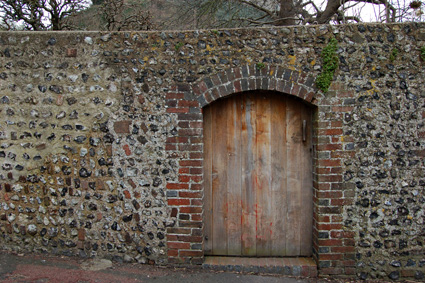
Doorway along Castle Lane
Lewes doesn't make the tourist map, at least for Americans. It's a good-sized town, with plenty to fill a day or two, but we went there just to get out of London, to go someplace that we knew we could go for proper tea and a relaxing walk. I'd learned of Lewes from Melissa, when we were both in Brighton, because it was just a short distance away but worlds apart. And you could sit down for tea and scones before making a visit to the local brewery and shop.
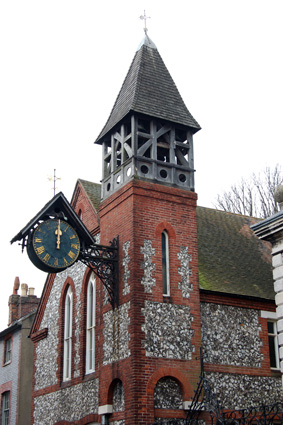
Tower and clock along High Street
It feels like a proper old English town, though I'm not entirely sure what that really is. But, if I had to hazard a guess, Lewes would be it. Settled in the Sussex hills, along the little River Ouse, the little, winding streets of Lewes are downright charming. Of course, since we went on a Saturday, a good number of other Britons had the same idea, but overcast skies and chilly winds kept the streets reasonably empty. By the time the afternoon soccer games had started, there wasn't a soul to be seen.
There are a handful of old buildings throughout town, and not much that looks terribly recent. It lends a distinct character, quite English, to the buildings, the streets, and everything. Even on the High Street, where giant plate glass retail windows are the norm, you find gems like the tower and clock above. Then, just a short stroll further along, you come across the Fifteenth Century Bookshop.
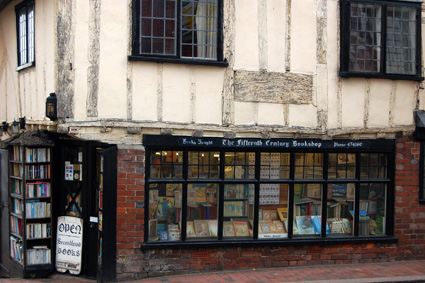
Fifteenth Century Bookshop
It's so called because the building's been standing since then. Now it's a bookstore specializing in secondhand books and children's literature, with books of all sorts piled and stacked in every available space, as one would expect. When I visited there years ago, the exterior was covered in scaffolding for facade repairs, so this was the first opportunity I'd had to see it all exposed. Though seeing masonry structures several centuries old isn't uncommon throughout Europe, an exposed timber frame is a little less ordinary.
Just inside the door is a list of all of the previous occupants of the building, as best can be determined. The list goes back hundreds of years, with only a few gaps, though a used bookstore, a business trading in history and imagination, really seems like the most appropriate tenant possible.

Fifteenth Century Bookshop
Older than the bookshop is Lewes Castle, perched atop a steep hill just about across the street. It's not much more than a small keep with an uninviting climb up for any would-be invaders, but you could certainly expect the best view in town from up there. Then again, the worm's-eye view of some of the imposing structures around the castle aren't too shabby, either, especially the imposing Barbican Gate:
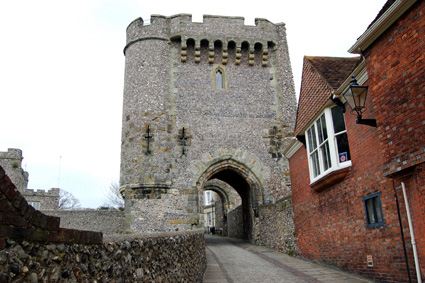
Barbican Gate
It's big, impressive, and a fascinating piece of history in an out-of-the-way sort of town. But it was also decidedly brisk outside, and we were more than happy to go someplace warm for a change. The primary reason for visiting Lewes was that we knew where we could find a good little shop for tea, and so that's where we went.
Robson's of Lewes is on the High Street as you approach the river, where the hill becomes steep enough that you're glad you're not driving. Or parallel parking. When we left for Lewes, I couldn't remember the name, but I knew I'd recognize it as soon as I saw it. Just a little shopfront along the street, it widens back into the building, and has a second seating area just a floor below, which is where I've always ended up. Upstairs, it seems, is always full when I arrive.
There's a general cafe menu of soups and sandwiches, and they seem to do a thriving lunch business - especially since things were just as busy as I remember from nearly seven years ago. We weren't there for the usual lunch, though. We went for tea.
Or half tea, really. The full tea includes finger sandwiches and all that. A half tea, as the menu calls it, consists of a pot of tea and two warm scones with butter, clotted cream and raspberry jam. There's enough of a coffeehouse atmosphere that you can linger a while, soaking in the warmth, before venturing back outside. One of my favorite things is that, by ordering a pot of tea, there's no need to specifically ask for no milk. Milky tea, as near as I can tell, is just the British way of rescuing tea that's been overextracted.2 Which is fine, if that's your thing, but I do wish folks wouldn't add it without asking.
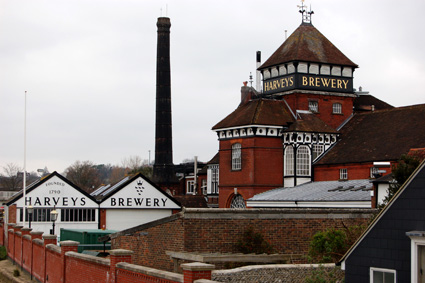
Harveys Brewery
From there, we decided to amble over to Harveys Brewery. You can't tour the brewery - at least, not without a prior appointment, which we certainly didn't have - but you can look through the brewery shop, which is endlessly fascinating. In addition to their many, many fine beers, ranging from bitters to pale ales to holiday brews, you can pick up a range of wines from around Britain and the world. Granted, the international selection's nothing to get overly excited about, but the fruit wines - many produced nearby in West Sussex - are fascinating.
I don't know if they're any good, of course, but the possibilities include: Parsnip Wine; Rose Petal Wine; Silver Birch Wine; Rhubarb Wine; and my personal favorite, because I don't know what to make of it, Black Beer & Raisin Wine. I have no idea what it is, but I'd buy a bottle if I saw it around here.
Leaving the brewery, crossing the Lewes Bridge, the air was rich with the smell of wort, dark malts and fresh hops.

Ruins of the Priory of St. Pancras
With time to kill, we consulted our handy visitor map, which listed the various sights of interest around Lewes. There's the Anne of Cleves House, built for the ex-wife of Henry VIII to provide her with an income; Lewes Castle and Harveys Brewery, which we'd already been by; and a little mark west of the Sussex Downs College playing fields noted "Lewes Priory (Remains)". That would be the Priory of St. Pancras, or the ruins thereof. The sign notes that informational brochures are available at the Tourist Information Centre, and there's a brief history noted, but it's essentially a collection of crumbling stone walls.
Photogenic ones, too, especially if you get up close enough to poke the camera lens through the fence.
By this point, we were back in the mode where the needs for food, warmth and restrooms were coming back to life, so we decided to find a decent place to eat, all the better to stave off our eventual return to London. Pubs are usually a safe bet, if you're willing to accept that fact that food quality can range anywhere from edible-but-unthrilling to top-notch-homestyle-comfort-food. But not all pubs serve food, and some only at limited hours. So it's best to approach with an open mind. I try to use beer quality as a barometer of food quality, but I'm not sure how foolproof that really is.
Given that, we stopped into The Brewery Arms, on High Street, in part because they were serving some Harveys brews, and because there was a menu outside that looked good enough. Despite being almost nestled among the shops, it appeared to be a low-key place for locals, and we relaxed at a corner table as a group of mostly old men argued about a variety of different nothings. I had a pint of Harveys Old Ale, which was rather like a traditional bitter with dark malts - medium bodied, lightly carbonated, with a noticeable but relaxed hop presence. Sharon enjoyed a half pint of Biddenden Kentish Cider, which was dry and quite delicious, and surprisingly alcoholic at 8.0%.
Dinner was straightforward pub food, which reminded me of something I'd long forgotten: though the British may have invented the sandwich, they don't really seem to get the hang of it. When they offer a pork sausage sandwich, it'll consist of pork sausages and bread. (Best to at least ask for some mustard or mayo.) And, somehow, most places still don't know how to properly cook french fries.3 Still, dinner was pretty good: the sausages weren't overcooked, like I've come to expect; Sharon's tomato soup was really good; and the onion rings were excellent and not at all greasy.
I was also cheered to see that the beer mats were from Harveys, highlighting its local, sustainable efforts. The front side is an sketch of the traditional barley and hops harvest. The back notes that Harveys sources its raw materials from local growers, and that it restricts its deliveries to a fifty mile radius, ensuring that the beers are tailored to the local palate. It's what I like to see.
Now, for one more photograph, just because I like it:
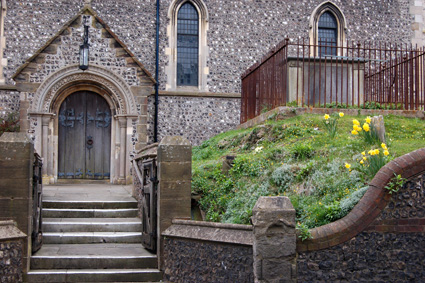
St. Anne's Church
* * * * *
1They would also have a restroom, which ends up being ever on one's mind when traveling. So you buy coffee or tea so you can use the facilities, and it just builds into a vicious cycle.
2It is funny, though, that the back of herbal teabag packets in Britain specifically state to drink without milk.
3Double-fry 'em, like the Belgians do with their frites. One time to cook the potato through, and a second time, at a higher temperature, to get the outside all crispy-crunchy. And, please, don't overcrowd the fryer. It drops the oil temperature so nothings crisps, and they all end up sticking together, anyhow.

Doorway along Castle Lane
Lewes doesn't make the tourist map, at least for Americans. It's a good-sized town, with plenty to fill a day or two, but we went there just to get out of London, to go someplace that we knew we could go for proper tea and a relaxing walk. I'd learned of Lewes from Melissa, when we were both in Brighton, because it was just a short distance away but worlds apart. And you could sit down for tea and scones before making a visit to the local brewery and shop.

Tower and clock along High Street
It feels like a proper old English town, though I'm not entirely sure what that really is. But, if I had to hazard a guess, Lewes would be it. Settled in the Sussex hills, along the little River Ouse, the little, winding streets of Lewes are downright charming. Of course, since we went on a Saturday, a good number of other Britons had the same idea, but overcast skies and chilly winds kept the streets reasonably empty. By the time the afternoon soccer games had started, there wasn't a soul to be seen.
There are a handful of old buildings throughout town, and not much that looks terribly recent. It lends a distinct character, quite English, to the buildings, the streets, and everything. Even on the High Street, where giant plate glass retail windows are the norm, you find gems like the tower and clock above. Then, just a short stroll further along, you come across the Fifteenth Century Bookshop.

Fifteenth Century Bookshop
It's so called because the building's been standing since then. Now it's a bookstore specializing in secondhand books and children's literature, with books of all sorts piled and stacked in every available space, as one would expect. When I visited there years ago, the exterior was covered in scaffolding for facade repairs, so this was the first opportunity I'd had to see it all exposed. Though seeing masonry structures several centuries old isn't uncommon throughout Europe, an exposed timber frame is a little less ordinary.
Just inside the door is a list of all of the previous occupants of the building, as best can be determined. The list goes back hundreds of years, with only a few gaps, though a used bookstore, a business trading in history and imagination, really seems like the most appropriate tenant possible.

Fifteenth Century Bookshop
Older than the bookshop is Lewes Castle, perched atop a steep hill just about across the street. It's not much more than a small keep with an uninviting climb up for any would-be invaders, but you could certainly expect the best view in town from up there. Then again, the worm's-eye view of some of the imposing structures around the castle aren't too shabby, either, especially the imposing Barbican Gate:

Barbican Gate
It's big, impressive, and a fascinating piece of history in an out-of-the-way sort of town. But it was also decidedly brisk outside, and we were more than happy to go someplace warm for a change. The primary reason for visiting Lewes was that we knew where we could find a good little shop for tea, and so that's where we went.
Robson's of Lewes is on the High Street as you approach the river, where the hill becomes steep enough that you're glad you're not driving. Or parallel parking. When we left for Lewes, I couldn't remember the name, but I knew I'd recognize it as soon as I saw it. Just a little shopfront along the street, it widens back into the building, and has a second seating area just a floor below, which is where I've always ended up. Upstairs, it seems, is always full when I arrive.
There's a general cafe menu of soups and sandwiches, and they seem to do a thriving lunch business - especially since things were just as busy as I remember from nearly seven years ago. We weren't there for the usual lunch, though. We went for tea.
Or half tea, really. The full tea includes finger sandwiches and all that. A half tea, as the menu calls it, consists of a pot of tea and two warm scones with butter, clotted cream and raspberry jam. There's enough of a coffeehouse atmosphere that you can linger a while, soaking in the warmth, before venturing back outside. One of my favorite things is that, by ordering a pot of tea, there's no need to specifically ask for no milk. Milky tea, as near as I can tell, is just the British way of rescuing tea that's been overextracted.2 Which is fine, if that's your thing, but I do wish folks wouldn't add it without asking.

Harveys Brewery
From there, we decided to amble over to Harveys Brewery. You can't tour the brewery - at least, not without a prior appointment, which we certainly didn't have - but you can look through the brewery shop, which is endlessly fascinating. In addition to their many, many fine beers, ranging from bitters to pale ales to holiday brews, you can pick up a range of wines from around Britain and the world. Granted, the international selection's nothing to get overly excited about, but the fruit wines - many produced nearby in West Sussex - are fascinating.
I don't know if they're any good, of course, but the possibilities include: Parsnip Wine; Rose Petal Wine; Silver Birch Wine; Rhubarb Wine; and my personal favorite, because I don't know what to make of it, Black Beer & Raisin Wine. I have no idea what it is, but I'd buy a bottle if I saw it around here.
Leaving the brewery, crossing the Lewes Bridge, the air was rich with the smell of wort, dark malts and fresh hops.

Ruins of the Priory of St. Pancras
With time to kill, we consulted our handy visitor map, which listed the various sights of interest around Lewes. There's the Anne of Cleves House, built for the ex-wife of Henry VIII to provide her with an income; Lewes Castle and Harveys Brewery, which we'd already been by; and a little mark west of the Sussex Downs College playing fields noted "Lewes Priory (Remains)". That would be the Priory of St. Pancras, or the ruins thereof. The sign notes that informational brochures are available at the Tourist Information Centre, and there's a brief history noted, but it's essentially a collection of crumbling stone walls.
Photogenic ones, too, especially if you get up close enough to poke the camera lens through the fence.
By this point, we were back in the mode where the needs for food, warmth and restrooms were coming back to life, so we decided to find a decent place to eat, all the better to stave off our eventual return to London. Pubs are usually a safe bet, if you're willing to accept that fact that food quality can range anywhere from edible-but-unthrilling to top-notch-homestyle-comfort-food. But not all pubs serve food, and some only at limited hours. So it's best to approach with an open mind. I try to use beer quality as a barometer of food quality, but I'm not sure how foolproof that really is.
Given that, we stopped into The Brewery Arms, on High Street, in part because they were serving some Harveys brews, and because there was a menu outside that looked good enough. Despite being almost nestled among the shops, it appeared to be a low-key place for locals, and we relaxed at a corner table as a group of mostly old men argued about a variety of different nothings. I had a pint of Harveys Old Ale, which was rather like a traditional bitter with dark malts - medium bodied, lightly carbonated, with a noticeable but relaxed hop presence. Sharon enjoyed a half pint of Biddenden Kentish Cider, which was dry and quite delicious, and surprisingly alcoholic at 8.0%.
Dinner was straightforward pub food, which reminded me of something I'd long forgotten: though the British may have invented the sandwich, they don't really seem to get the hang of it. When they offer a pork sausage sandwich, it'll consist of pork sausages and bread. (Best to at least ask for some mustard or mayo.) And, somehow, most places still don't know how to properly cook french fries.3 Still, dinner was pretty good: the sausages weren't overcooked, like I've come to expect; Sharon's tomato soup was really good; and the onion rings were excellent and not at all greasy.
I was also cheered to see that the beer mats were from Harveys, highlighting its local, sustainable efforts. The front side is an sketch of the traditional barley and hops harvest. The back notes that Harveys sources its raw materials from local growers, and that it restricts its deliveries to a fifty mile radius, ensuring that the beers are tailored to the local palate. It's what I like to see.
Now, for one more photograph, just because I like it:

St. Anne's Church
* * * * *
1They would also have a restroom, which ends up being ever on one's mind when traveling. So you buy coffee or tea so you can use the facilities, and it just builds into a vicious cycle.
2It is funny, though, that the back of herbal teabag packets in Britain specifically state to drink without milk.
3Double-fry 'em, like the Belgians do with their frites. One time to cook the potato through, and a second time, at a higher temperature, to get the outside all crispy-crunchy. And, please, don't overcrowd the fryer. It drops the oil temperature so nothings crisps, and they all end up sticking together, anyhow.
Europe 2007 - Naxos.
Madison.
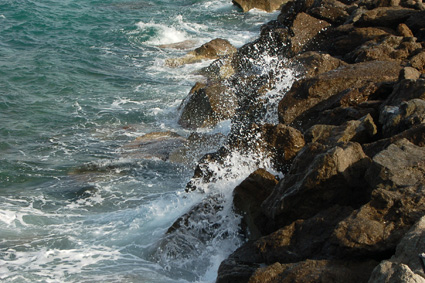
Sea spray along causeway, Naxos
Naxos is the sort of place people mean when they say they could spend the rest of their days on an island in the Mediterranean. (Or, in this case, the Aegean Sea.) Perhaps we'd have had a less engaging experience at the height of tourist season, but we were so off-season1 that much of the island was closed down. The main town, called either Chora or Naxos, was still alive, with the majority of the shops and restaurants open for business - but that was far from the case in the smaller resort towns, which were ghost towns save for the work crews readying the hotels for the coming tourist hordes.
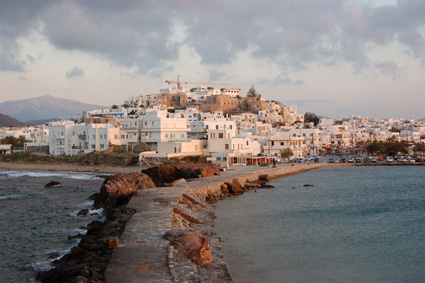
Chora, Naxos
Although it's possible to get puddlehopper flights to Naxos, most everyone arrives on the ferry. In the peak season, there are five or six ferries a day from Piraeus, the main port serving Athens, but we had a choice of two: one that left the mainland at 7:30am; another that wouldn't arrive in Naxos until nearly midnight. We opted for the former, and spent five rather comfortable hours aboard a monstrous ferry that had not only hundreds of travelers, but two decks' worth of cars, including several full-size semi trailers. Some got off at Paros, the only stop before Naxos, and some continued on to other islands, though we never did figure out which ones.
We arrived on a day that was like every other during our stay: brilliant sun, with enough haze in the air to make Paros seem far away, and a wind that made the days pleasant but the nights chilly. As far as we were concerned, the weather was wonderful, ideal for short sleeves and long walks. The locals, on the other hand, were bundled up in sweaters and jackets at pretty much all times, and were amazed that we'd left home with snow on the ground and wouldn't be surprised to have another significant snowfall once we went home.
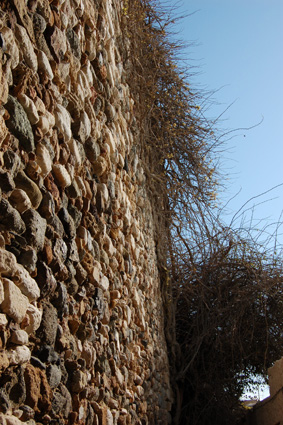
Coarse stone wall in Kastro
At the center of the old town is the Kastro, an ancient hilltop castle, though in a rather loose sense compared to the imposing fortresses that I think of as European castles. These days, it's a warren of narrow, twisting streets and stairs connecting residences, a pair of museums, and an old Roman Catholic church. For the most part, the buildings throughout the island - in the Kastro and elsewhere - are white plaster with blue shutters. In the Kastro, though, there are a few fascinating old rough stone walls, like above, and a sense of history in the mismatched architectural styles as buildings were patched, torn down, replaced.
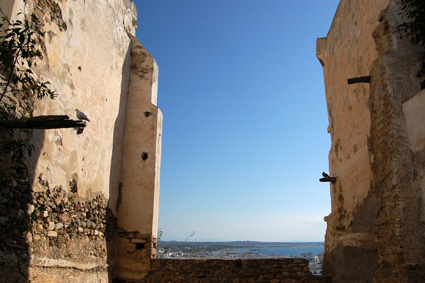
Fallen building within Kastro perimeter
Then, occasionally, there's something that remains fallen. When we first walked through the Kastro, it was during the midafternoon siesta, and everything was quiet, even the construction crew working on the historical buildings. Only the birds - pigeons, mostly - and the cats were active. Though there were a handful of stray dogs about the town, there were cats everywhere on the island. This fallen building seemed to be one of their favorite places to congregate, giving them a variety of places to perch and devour their kills; little bones of birds, rodents and fish littered the area. Still, we felt as though we had the entire place to ourselves, which, in a way, we did.
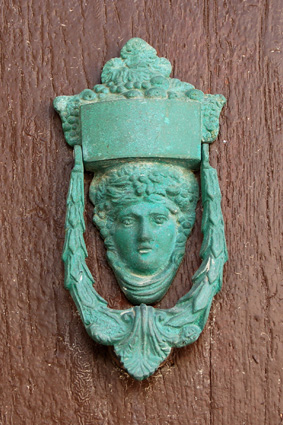
Door knocker detail, Kastro
Throughout Greece, we found a juxtaposition of charming, well-kept elements alongside old, crumbling wrecks. The Kastro was no different. The residences - presumably some of the most expensive real estate on the island - were in good repair, often with fascinating architectural details like the ornate door knocker above. Others maintained miniature gardens, with flowers, grape vines, and flowering trees, nestled within the nooks. But just a few steps away would be semi-derelict structures, with a patchwork of quick-fix repairs, which may or may not have been occupied.
The best-known sight on the island of Naxos, of course, is also a ruin. On a hill at the northwest edge of Chora, connected by a causeway, is the 2500-year-old Temple of Apollo, though nothing remains but the massive gate and scattered stones.
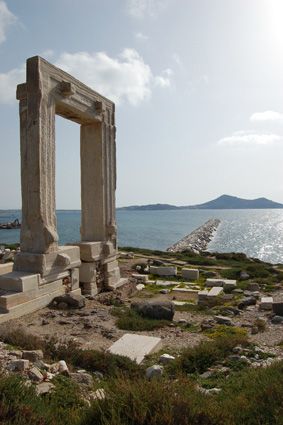
Temple of Apollo gate
In the summer, we're told, there's hardly a spot to stand around the temple, and it's obvious that the scraggly vegetation covering the hill takes a serious beating. A myriad of meandering little footpaths scatter every which way, and it's not a terribly large hill. The prettiest time to be there - and the time we saw the most people - was at sunset, because the west-ish facing gate frames the sunset quite well. Including ourselves, there were a total of six people on the hill, including a professional photographer who must have taken dozens of shots of the sunset, like this:
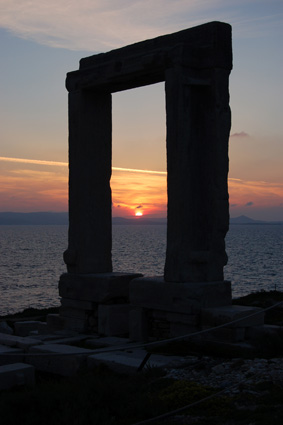
Temple of Apollo gate at sunset
Eating isn't a problem on Naxos, assuming you like seafood and don't mind limiting your vegetables to Greek salads. In essence, you can rely on it for your evening's entertainment, especially as we had the restaurants more or less to ourselves. Mezedes were the easiest way to go, particularly at night, though souvlaki and gyros made for simple lunches, especially when the island had settled into siesta time.
In Chora, it's tough to find someone who doesn't speak English - often before you even have time to say kali spera. But the menus are both in Greek and English, and it's not hard to find something good to eat. We did learn, though, that when the menu item is, say, fish, then that's all you'll get. Maybe a tiny little side salad consisting of three bites of spinach, and often a wedge of lemon, but we were hungry for fresh vegetables by the time we left. Out-of-season tomatoes, cucumbers, and cabbage weren't quite cutting it.2
The good stuff, though, included things like deep-fried little shrimp with ouzo, with just a very thin coating, which seemed to be the norm. They came with heads on, so you plucked them off, sucked out any remaining juices, and ate the rest, crunching the shell. Or little fish - larger than anchovies, but smaller than sardines - fried and eaten whole, which were among my favorite dishes there, rivalled by the grilled sardines, which were delicious dipped in a vinaigrette with lemon and olive oil. Peppers stuffed with soft cheese; rice with mussels; fried octopus balls; the local loukaniko sausage, made from pork, loaded with spices, and cooked to a state of perfect juiciness. Aside from some watery, imported tomatoes, there wasn't much there not to like.3

Chapel bell
And there's plenty of good stuff to drink, too. Ouzo, of course, which you can order by the glass or by the 200mL bottle for two. There was even a local ouzo to be had, though I didn't notice until later on. One night we shared a bottle of some local white wine, which was unremarkable table wine, but just fine for drinking with dinner. Another night I had a half kilo4 of retsina, the white wine flavored with pine resin, along with a glas of raki, the Greek version of grappa. Then there were some more unusual spirits that we very much enjoyed.
Though we couldn't bring it home - for fear of the bottle breaking en route - we were pleasantly surprised by a spiced, sweetened cherry brandy we found. I don't seem to have written the name down, though I imagine I'll find it around someday. The other, which we did bring back, was Naxian Kitron a strong liqueur made from the leaves of the local kitron tree. It's similar to the Italian limoncello. We were told that the leaves are used to flavor the liqueur, and that the rind of the fruit is candied in syrup, but that the flesh of the kitron itself is nearly inedible. We never saw any of the kitron trees; the orchards, I think, are clustered in the center of the island, where we weren't able to travel.
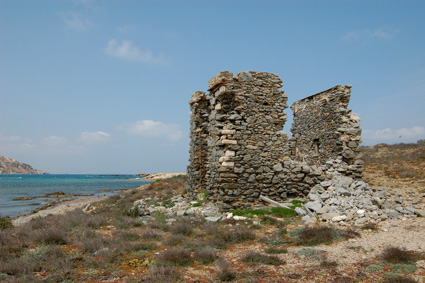
Ruins along the beach
When nothing much is open on Naxos, and there's but one bus per day - it runs, for four hours, out to the far end of the island, then doubles back - entertainment options tend to be rather low-key. But that comes with a lovely tradeoff, of having the beaches all to yourself. We walked for hours one day, along the beach of Aghios Georgios to the still-asleep cluster of little resorts and summer homes of Aghios Prokopios; then down to the lovely beaches of Aghia Anna, where a pair of fishing boats were just returning to port. Aside from that, the only people we saw were workers doing maintenance on the hotels after the winter months.
Even the "All Seasons Cafe" was closed.
From that point, we walked east to Aghios Arsenios, though we didn't know what, if anything, we might find there. The roads weren't empty, though traffic was more than light, as we left the little seaside resort areas and entered an array of small farms. These weren't small farms, in the American sense,5 where a hundred acres is still pretty tiny. Some of these were miniature, with just a handful of livestock, and tiny plots of land. On one, a man was cutting grasses with a hand scythe; others might have two or three cows, or goats, or sheep, or maybe a dozen or so chickens running about the olive, lemon and orange trees.

Naxian rooster
The citrus was ripe, or nearly so, brightly orange and yellow, while the olive trees were just beginning to flower, and the grapevines were just awaking from their winter dormancy. Most of the fields were just being planted, or were still waiting for the winter cover crops - what looked like wheat or barley - to be plowed under. Wildflowers were in bloom in these fields, an eruption of colors that made for a lovely landscape in the afternoon sun. Whites and yellows, with the occasional purple; we even saw some lovely hibiscus flowers covering an old stone wall. Add to that red poppies, with a color so intense that it just about overwhelmed the camera's sensors:
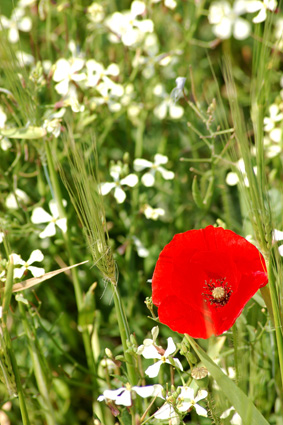
Poppy flower
It really was a beautiful place; though it seems quite a stretch to think I'd want to retire there someday, you can almost understand it when you think that you'd have these sorts of views just outside your door.
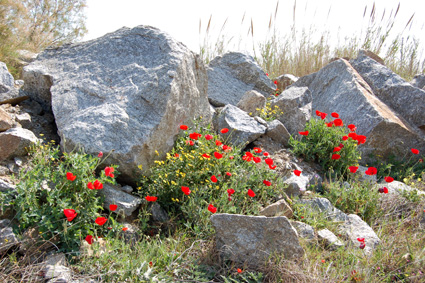
Poppies
* * * * *
1For the most part, "off-season" in the Cyclades doesn't even start until after Easter, nearly a week after we'd already been through.
2Maybe that works for some folks, but not us. Keep in mind that we were going directly from Greece to Scotland, popularly known for deep-frying everything imaginable - Mars bars, most notably - not unlike some Minnesotans I know.
3Oh, there was also the "greens" I had ordered under a salad section of a menu. Rather than a salad full of greens, it was something not unlike collards, boiled to death. I like collards, simmered until tender with some sort of pork, but this was anything but that.
4That's what the menu said. The red and white wines were listed in liter quantities; the retsina and a few others in kilo amounts. It's essentially the same thing in this case, and I've no idea why they did it that way.
5This doesn't fit anywhere else, but I feel compelled to note it. One evening, sitting in the lobby or our little hotel, chatting with Dimitris, a local man who helps run the hotel, and drinking some Greek coffee, we met an American couple. Some very nice folks from Beaver Springs, Pennsylvania, not thirty miles from what will be our new home. And it turns out that Kristen and Mike run Sweet Meriam's Farm, an organic CSA that counts a number of Bucknell faculty among its members. It was, really, the most amazing of coincidences.

Sea spray along causeway, Naxos
Naxos is the sort of place people mean when they say they could spend the rest of their days on an island in the Mediterranean. (Or, in this case, the Aegean Sea.) Perhaps we'd have had a less engaging experience at the height of tourist season, but we were so off-season1 that much of the island was closed down. The main town, called either Chora or Naxos, was still alive, with the majority of the shops and restaurants open for business - but that was far from the case in the smaller resort towns, which were ghost towns save for the work crews readying the hotels for the coming tourist hordes.

Chora, Naxos
Although it's possible to get puddlehopper flights to Naxos, most everyone arrives on the ferry. In the peak season, there are five or six ferries a day from Piraeus, the main port serving Athens, but we had a choice of two: one that left the mainland at 7:30am; another that wouldn't arrive in Naxos until nearly midnight. We opted for the former, and spent five rather comfortable hours aboard a monstrous ferry that had not only hundreds of travelers, but two decks' worth of cars, including several full-size semi trailers. Some got off at Paros, the only stop before Naxos, and some continued on to other islands, though we never did figure out which ones.
We arrived on a day that was like every other during our stay: brilliant sun, with enough haze in the air to make Paros seem far away, and a wind that made the days pleasant but the nights chilly. As far as we were concerned, the weather was wonderful, ideal for short sleeves and long walks. The locals, on the other hand, were bundled up in sweaters and jackets at pretty much all times, and were amazed that we'd left home with snow on the ground and wouldn't be surprised to have another significant snowfall once we went home.

Coarse stone wall in Kastro
At the center of the old town is the Kastro, an ancient hilltop castle, though in a rather loose sense compared to the imposing fortresses that I think of as European castles. These days, it's a warren of narrow, twisting streets and stairs connecting residences, a pair of museums, and an old Roman Catholic church. For the most part, the buildings throughout the island - in the Kastro and elsewhere - are white plaster with blue shutters. In the Kastro, though, there are a few fascinating old rough stone walls, like above, and a sense of history in the mismatched architectural styles as buildings were patched, torn down, replaced.

Fallen building within Kastro perimeter
Then, occasionally, there's something that remains fallen. When we first walked through the Kastro, it was during the midafternoon siesta, and everything was quiet, even the construction crew working on the historical buildings. Only the birds - pigeons, mostly - and the cats were active. Though there were a handful of stray dogs about the town, there were cats everywhere on the island. This fallen building seemed to be one of their favorite places to congregate, giving them a variety of places to perch and devour their kills; little bones of birds, rodents and fish littered the area. Still, we felt as though we had the entire place to ourselves, which, in a way, we did.

Door knocker detail, Kastro
Throughout Greece, we found a juxtaposition of charming, well-kept elements alongside old, crumbling wrecks. The Kastro was no different. The residences - presumably some of the most expensive real estate on the island - were in good repair, often with fascinating architectural details like the ornate door knocker above. Others maintained miniature gardens, with flowers, grape vines, and flowering trees, nestled within the nooks. But just a few steps away would be semi-derelict structures, with a patchwork of quick-fix repairs, which may or may not have been occupied.
The best-known sight on the island of Naxos, of course, is also a ruin. On a hill at the northwest edge of Chora, connected by a causeway, is the 2500-year-old Temple of Apollo, though nothing remains but the massive gate and scattered stones.

Temple of Apollo gate
In the summer, we're told, there's hardly a spot to stand around the temple, and it's obvious that the scraggly vegetation covering the hill takes a serious beating. A myriad of meandering little footpaths scatter every which way, and it's not a terribly large hill. The prettiest time to be there - and the time we saw the most people - was at sunset, because the west-ish facing gate frames the sunset quite well. Including ourselves, there were a total of six people on the hill, including a professional photographer who must have taken dozens of shots of the sunset, like this:

Temple of Apollo gate at sunset
Eating isn't a problem on Naxos, assuming you like seafood and don't mind limiting your vegetables to Greek salads. In essence, you can rely on it for your evening's entertainment, especially as we had the restaurants more or less to ourselves. Mezedes were the easiest way to go, particularly at night, though souvlaki and gyros made for simple lunches, especially when the island had settled into siesta time.
In Chora, it's tough to find someone who doesn't speak English - often before you even have time to say kali spera. But the menus are both in Greek and English, and it's not hard to find something good to eat. We did learn, though, that when the menu item is, say, fish, then that's all you'll get. Maybe a tiny little side salad consisting of three bites of spinach, and often a wedge of lemon, but we were hungry for fresh vegetables by the time we left. Out-of-season tomatoes, cucumbers, and cabbage weren't quite cutting it.2
The good stuff, though, included things like deep-fried little shrimp with ouzo, with just a very thin coating, which seemed to be the norm. They came with heads on, so you plucked them off, sucked out any remaining juices, and ate the rest, crunching the shell. Or little fish - larger than anchovies, but smaller than sardines - fried and eaten whole, which were among my favorite dishes there, rivalled by the grilled sardines, which were delicious dipped in a vinaigrette with lemon and olive oil. Peppers stuffed with soft cheese; rice with mussels; fried octopus balls; the local loukaniko sausage, made from pork, loaded with spices, and cooked to a state of perfect juiciness. Aside from some watery, imported tomatoes, there wasn't much there not to like.3

Chapel bell
And there's plenty of good stuff to drink, too. Ouzo, of course, which you can order by the glass or by the 200mL bottle for two. There was even a local ouzo to be had, though I didn't notice until later on. One night we shared a bottle of some local white wine, which was unremarkable table wine, but just fine for drinking with dinner. Another night I had a half kilo4 of retsina, the white wine flavored with pine resin, along with a glas of raki, the Greek version of grappa. Then there were some more unusual spirits that we very much enjoyed.
Though we couldn't bring it home - for fear of the bottle breaking en route - we were pleasantly surprised by a spiced, sweetened cherry brandy we found. I don't seem to have written the name down, though I imagine I'll find it around someday. The other, which we did bring back, was Naxian Kitron a strong liqueur made from the leaves of the local kitron tree. It's similar to the Italian limoncello. We were told that the leaves are used to flavor the liqueur, and that the rind of the fruit is candied in syrup, but that the flesh of the kitron itself is nearly inedible. We never saw any of the kitron trees; the orchards, I think, are clustered in the center of the island, where we weren't able to travel.

Ruins along the beach
When nothing much is open on Naxos, and there's but one bus per day - it runs, for four hours, out to the far end of the island, then doubles back - entertainment options tend to be rather low-key. But that comes with a lovely tradeoff, of having the beaches all to yourself. We walked for hours one day, along the beach of Aghios Georgios to the still-asleep cluster of little resorts and summer homes of Aghios Prokopios; then down to the lovely beaches of Aghia Anna, where a pair of fishing boats were just returning to port. Aside from that, the only people we saw were workers doing maintenance on the hotels after the winter months.
Even the "All Seasons Cafe" was closed.
From that point, we walked east to Aghios Arsenios, though we didn't know what, if anything, we might find there. The roads weren't empty, though traffic was more than light, as we left the little seaside resort areas and entered an array of small farms. These weren't small farms, in the American sense,5 where a hundred acres is still pretty tiny. Some of these were miniature, with just a handful of livestock, and tiny plots of land. On one, a man was cutting grasses with a hand scythe; others might have two or three cows, or goats, or sheep, or maybe a dozen or so chickens running about the olive, lemon and orange trees.

Naxian rooster
The citrus was ripe, or nearly so, brightly orange and yellow, while the olive trees were just beginning to flower, and the grapevines were just awaking from their winter dormancy. Most of the fields were just being planted, or were still waiting for the winter cover crops - what looked like wheat or barley - to be plowed under. Wildflowers were in bloom in these fields, an eruption of colors that made for a lovely landscape in the afternoon sun. Whites and yellows, with the occasional purple; we even saw some lovely hibiscus flowers covering an old stone wall. Add to that red poppies, with a color so intense that it just about overwhelmed the camera's sensors:

Poppy flower
It really was a beautiful place; though it seems quite a stretch to think I'd want to retire there someday, you can almost understand it when you think that you'd have these sorts of views just outside your door.

Poppies
* * * * *
1For the most part, "off-season" in the Cyclades doesn't even start until after Easter, nearly a week after we'd already been through.
2Maybe that works for some folks, but not us. Keep in mind that we were going directly from Greece to Scotland, popularly known for deep-frying everything imaginable - Mars bars, most notably - not unlike some Minnesotans I know.
3Oh, there was also the "greens" I had ordered under a salad section of a menu. Rather than a salad full of greens, it was something not unlike collards, boiled to death. I like collards, simmered until tender with some sort of pork, but this was anything but that.
4That's what the menu said. The red and white wines were listed in liter quantities; the retsina and a few others in kilo amounts. It's essentially the same thing in this case, and I've no idea why they did it that way.
5This doesn't fit anywhere else, but I feel compelled to note it. One evening, sitting in the lobby or our little hotel, chatting with Dimitris, a local man who helps run the hotel, and drinking some Greek coffee, we met an American couple. Some very nice folks from Beaver Springs, Pennsylvania, not thirty miles from what will be our new home. And it turns out that Kristen and Mike run Sweet Meriam's Farm, an organic CSA that counts a number of Bucknell faculty among its members. It was, really, the most amazing of coincidences.
Europe 2007 - Athens.
Madison.
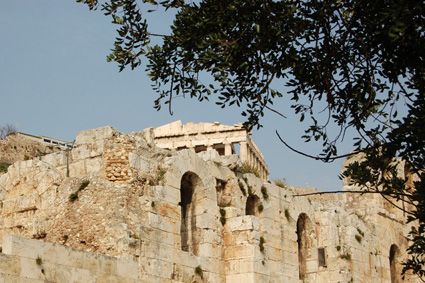
Parthenon atop Acropolis
We spent an absolute minimum of time in Athens, based on the following:
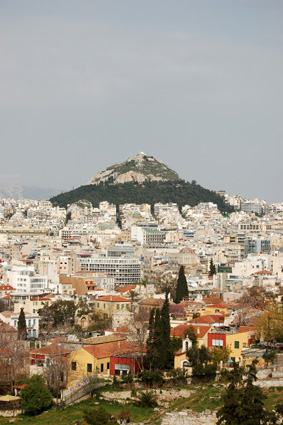
Athens, Greece
Our second pass through Athens was still brief, from the midafternoon when our ferry arrived from the islands, until our noon flight to London the next day. Still, there was enough time to race through the Acropolis, and that was all that I really wanted to do in Athens.
Our guidebook listed the wrong times for visiting the Acropolis, which meant that we arrived that first afternoon, at about 4:20pm, just ten minutes before they started to shoo people off the hill. Twelve euros seems like an awful lot of money to barely scurry up to the top, so we took note of the morning's opening time - 8:00am, giving us a little more than an hour to explore before racing off to the airport - and tried to see as much of it as we could from the outside.
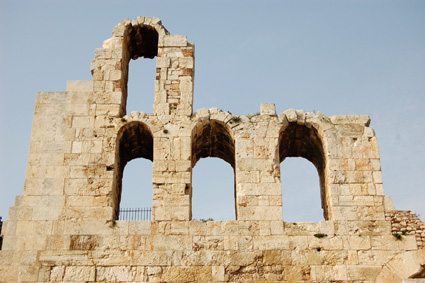
Facade of the Odeon of Herodes Atticus
Which, actually, was quite a lot. If you're willing to stretch a little, and stick your camera, arms, and sometimes head over and through the fences, you can almost make it seem as though you've seen all kinds of things that you simply walked past. And in Athens, where you can hardly go ten steps without running across another set of crumbling ruins, or little old church, or something else worth photographing. It's not the sort of place I'd want to live - the air pollution1 alone is enough to wipe it off the list of places I'll consider visiting again - but you sure can make it look lovely with pictures.

Temple of Hephaestus
Which is essentially what I plan to do. In the tweny-one hours we spent in the city - including the interminable wait at the airport, time asleep, and such - I managed to take about 175 pictures. The majority of those being at the Acropolis in one hour of the morning. It didn't leave much time for lengthy perusals of the signs or our guidebook, which means that, in some cases, I don't have a clue what it is that I've photographed.

Detail on Church of Agios Eleftherios
There's a patchwork, haphazard quality to Athens, much like we saw on Naxos. A cobbling of architectural styles - often the vernacular of various centuries - seems charming in some cases, but often more than a little sad. There's a sense that the city has begun to take better care of its ancient artifacts recently, but that, for centuries and longer, a great number of historical treasures were simply ignored, or worse.
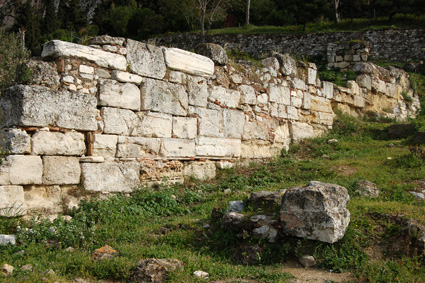
Ancient ruins on Acropolis slope
And Athens is full of tourists. Hordes of them, sometimes moving about in massive groups. I can't imagine what summer is like. Though I suppose that's what some people want - the packaged tour, bouncing from ancient sight to ancient sight, traveling about in the marginal comfort of a coach bus - but I'll pass. I've no desire to go on a cruise, either.
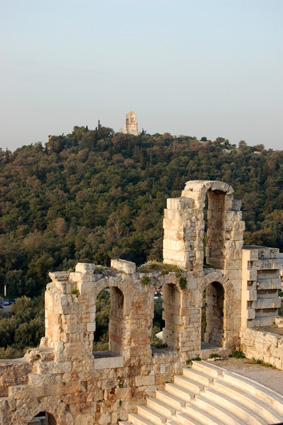
Odeon of Herodes Atticus from Acropolis
So, assuming you're like me, and you've made every effort to avoid the tourist-centric areas, as well as the accompanying crowds and crappy souvenirs, you'll be somewhat conflicted when it comes to ancient treasures like the Acropolis. You're guaranteed to find tourists of every imaginable stripe, and lots of them, but it's the Acropolis. Study enough architecture and you'll feel an almost overwhelming need to see it. A sense that there's something there, like the skies of the American west, that photographs just can't capture.2
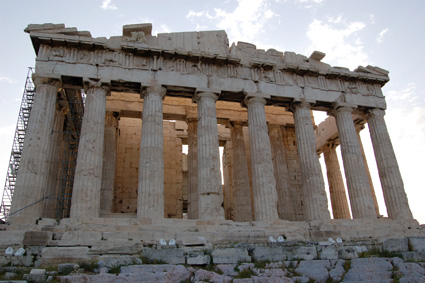
Parthenon, west facade at sunrise
As near as I can tell, the best time to visit the Acropolis is as soon as it opens in the morning. The package tours won't have their act together to arrive then, and the Greeks certainly aren't up and about - especially the vendors hawking junk. You won't have the place to yourself, but staying light on your feet means you'll have the best possible opportunities for keeping random people out of your shots.
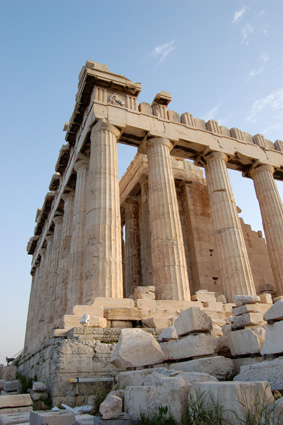
Parthenon, southwest corner
And the light... the rising sun, painting the ancient marble in warm sunlight, a sidelight with the sky still dark as a backdrop. It could only be finer with a richly colored, pollution-enhanced sunset behind.

Parthenon, east facade at sunrise
Scaffolding's an issue. The Parthenon has been undergoing a massive reconstruction project since 2000, and it's far from complete. When finished, it'll be brilliant, as close as possible to the state it was in before the invading Turks decided it'd be the handiest place to store gunpowder. But it does require some serious masonry work, including efforts to repair all of the mistakes made during the botched restoration effort in the early 20th century.

Altar of Rome and Augustus
Another problem is the occasional missing element. The Altar of Rome and Augustus is a pile of stacked ruins, awaiting reconstruction, which lends it the air of an organized mess. But the massive statue of Athena, which was supposed to have undergone restoration and to have been replaced in time for the 2004 Olympics, is still missing. And then there are the various bits and pieces, most taken by Lord Elgin, that are still in Britain3 despite repeated Greek requests to have them returned.
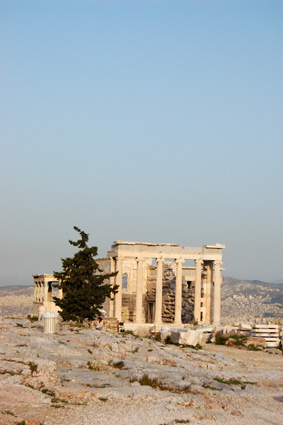
Erechtheion
In general, it's a rocky, slippery place on the Acropolis, with marble worn smooth by thousands of years' worth of feet wearing everything to a dull shine, rounding off the nosings of each stair tread. Not much of it is level, either, meaning that it's best to give your feet the occasional glance, lest you end up sprawled out in a most embarrassing fashion.
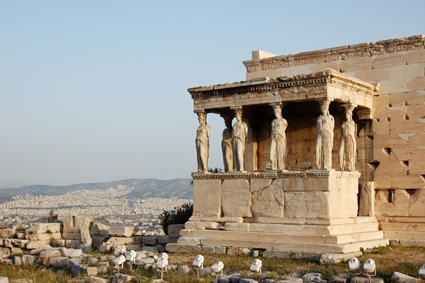
Karyatid porch of Erectheion
May I also recommend that, if you want good pictures, that you run around, shooting everything first and then return to read signs. By 8:30am, the first of the tourist groups - in our case, a bunch of thoroughly nonplussed Spanish adolescents who'd have rather been anywhere else - will begin to appear, often to start their day by watching the flag-raising ceremony at the east end. I'm not entirely clear on why it took six men with automatic weapons and camouflage uniforms to raise the flag, but that seems to be the case. Take advantage of everyone watching and get your last good pictures in.

Ancient artwork in Acropolis Museum
Then there's always the Acropolis Museum, a small collection showcasing many of the fascinating pieces artwork from about the Acropolis, preserved inside for close-up examination. Replicas replace them outside - in the case of the Karyatids - or will replace them, once restoration is complete. Beware the tour groups, however; it's a tight space for the volumes of people who move through.
On your way down, eventually, I recommend one of the many well-worn footpaths that will take you back to Athens without having to resort to the main road. You won't have them all to yourself, of course, but it's as close as you'll get. The trees temper the noise of the city, and, with a little luck, you'll see the little flowers and plants that are slowly tearing apart what's left of the ancient ruins.
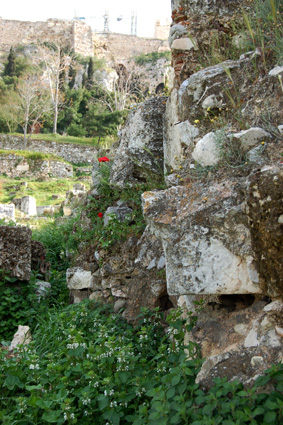
Poppies growing on ancient ruins
* * * * *
1When we arrived from the islands, stepping out from the subway at Monastiraki, Sharon asked if we were at a higher elevation. No, it was just about sea level, but the filth in the air was enough to make you feel like you were halfway to Machu Picchu.
2Same goes for these ones. Sorry.
3Including the Parthenon Marbles (also called the Elgin Marbles) and one of the Karyatids. I'm pleased to note that the new Acropolis Museum, when completed, will have empty spaces specifically reserved for these elements, which may finally be enough to prompt their return.

Parthenon atop Acropolis
We spent an absolute minimum of time in Athens, based on the following:
- No one we knew had good things to say about Athens. Reactions ranged from general ambivalence to outright hatred for the city. Even tourists in Paris sometimes love the place.
- The guidebook had a lot of charming things to note about the city, particularly with regard to fun aspects like pickpockets and taxi drivers renowned as some of the world's worst. Even the hotel, confirming our reservations, made sure to warn us specifically against the cab drivers trying to rip is off.
- We had a limited time in Greece to split between Athens and the islands. It's not as though it was a difficult choice.

Athens, Greece
Our second pass through Athens was still brief, from the midafternoon when our ferry arrived from the islands, until our noon flight to London the next day. Still, there was enough time to race through the Acropolis, and that was all that I really wanted to do in Athens.
Our guidebook listed the wrong times for visiting the Acropolis, which meant that we arrived that first afternoon, at about 4:20pm, just ten minutes before they started to shoo people off the hill. Twelve euros seems like an awful lot of money to barely scurry up to the top, so we took note of the morning's opening time - 8:00am, giving us a little more than an hour to explore before racing off to the airport - and tried to see as much of it as we could from the outside.

Facade of the Odeon of Herodes Atticus
Which, actually, was quite a lot. If you're willing to stretch a little, and stick your camera, arms, and sometimes head over and through the fences, you can almost make it seem as though you've seen all kinds of things that you simply walked past. And in Athens, where you can hardly go ten steps without running across another set of crumbling ruins, or little old church, or something else worth photographing. It's not the sort of place I'd want to live - the air pollution1 alone is enough to wipe it off the list of places I'll consider visiting again - but you sure can make it look lovely with pictures.

Temple of Hephaestus
Which is essentially what I plan to do. In the tweny-one hours we spent in the city - including the interminable wait at the airport, time asleep, and such - I managed to take about 175 pictures. The majority of those being at the Acropolis in one hour of the morning. It didn't leave much time for lengthy perusals of the signs or our guidebook, which means that, in some cases, I don't have a clue what it is that I've photographed.

Detail on Church of Agios Eleftherios
There's a patchwork, haphazard quality to Athens, much like we saw on Naxos. A cobbling of architectural styles - often the vernacular of various centuries - seems charming in some cases, but often more than a little sad. There's a sense that the city has begun to take better care of its ancient artifacts recently, but that, for centuries and longer, a great number of historical treasures were simply ignored, or worse.

Ancient ruins on Acropolis slope
And Athens is full of tourists. Hordes of them, sometimes moving about in massive groups. I can't imagine what summer is like. Though I suppose that's what some people want - the packaged tour, bouncing from ancient sight to ancient sight, traveling about in the marginal comfort of a coach bus - but I'll pass. I've no desire to go on a cruise, either.

Odeon of Herodes Atticus from Acropolis
So, assuming you're like me, and you've made every effort to avoid the tourist-centric areas, as well as the accompanying crowds and crappy souvenirs, you'll be somewhat conflicted when it comes to ancient treasures like the Acropolis. You're guaranteed to find tourists of every imaginable stripe, and lots of them, but it's the Acropolis. Study enough architecture and you'll feel an almost overwhelming need to see it. A sense that there's something there, like the skies of the American west, that photographs just can't capture.2

Parthenon, west facade at sunrise
As near as I can tell, the best time to visit the Acropolis is as soon as it opens in the morning. The package tours won't have their act together to arrive then, and the Greeks certainly aren't up and about - especially the vendors hawking junk. You won't have the place to yourself, but staying light on your feet means you'll have the best possible opportunities for keeping random people out of your shots.

Parthenon, southwest corner
And the light... the rising sun, painting the ancient marble in warm sunlight, a sidelight with the sky still dark as a backdrop. It could only be finer with a richly colored, pollution-enhanced sunset behind.

Parthenon, east facade at sunrise
Scaffolding's an issue. The Parthenon has been undergoing a massive reconstruction project since 2000, and it's far from complete. When finished, it'll be brilliant, as close as possible to the state it was in before the invading Turks decided it'd be the handiest place to store gunpowder. But it does require some serious masonry work, including efforts to repair all of the mistakes made during the botched restoration effort in the early 20th century.

Altar of Rome and Augustus
Another problem is the occasional missing element. The Altar of Rome and Augustus is a pile of stacked ruins, awaiting reconstruction, which lends it the air of an organized mess. But the massive statue of Athena, which was supposed to have undergone restoration and to have been replaced in time for the 2004 Olympics, is still missing. And then there are the various bits and pieces, most taken by Lord Elgin, that are still in Britain3 despite repeated Greek requests to have them returned.

Erechtheion
In general, it's a rocky, slippery place on the Acropolis, with marble worn smooth by thousands of years' worth of feet wearing everything to a dull shine, rounding off the nosings of each stair tread. Not much of it is level, either, meaning that it's best to give your feet the occasional glance, lest you end up sprawled out in a most embarrassing fashion.

Karyatid porch of Erectheion
May I also recommend that, if you want good pictures, that you run around, shooting everything first and then return to read signs. By 8:30am, the first of the tourist groups - in our case, a bunch of thoroughly nonplussed Spanish adolescents who'd have rather been anywhere else - will begin to appear, often to start their day by watching the flag-raising ceremony at the east end. I'm not entirely clear on why it took six men with automatic weapons and camouflage uniforms to raise the flag, but that seems to be the case. Take advantage of everyone watching and get your last good pictures in.

Ancient artwork in Acropolis Museum
Then there's always the Acropolis Museum, a small collection showcasing many of the fascinating pieces artwork from about the Acropolis, preserved inside for close-up examination. Replicas replace them outside - in the case of the Karyatids - or will replace them, once restoration is complete. Beware the tour groups, however; it's a tight space for the volumes of people who move through.
On your way down, eventually, I recommend one of the many well-worn footpaths that will take you back to Athens without having to resort to the main road. You won't have them all to yourself, of course, but it's as close as you'll get. The trees temper the noise of the city, and, with a little luck, you'll see the little flowers and plants that are slowly tearing apart what's left of the ancient ruins.

Poppies growing on ancient ruins
* * * * *
1When we arrived from the islands, stepping out from the subway at Monastiraki, Sharon asked if we were at a higher elevation. No, it was just about sea level, but the filth in the air was enough to make you feel like you were halfway to Machu Picchu.
2Same goes for these ones. Sorry.
3Including the Parthenon Marbles (also called the Elgin Marbles) and one of the Karyatids. I'm pleased to note that the new Acropolis Museum, when completed, will have empty spaces specifically reserved for these elements, which may finally be enough to prompt their return.
Europe 2007 - Edinburgh.
Madison.
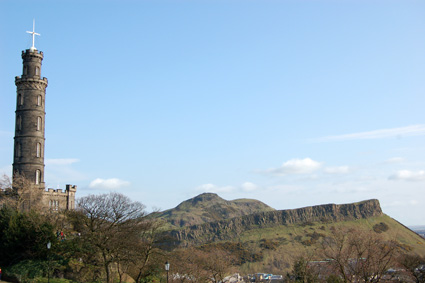
Arthur's Seat from Calton Hill
If there was one thing we hadn't expected to find it Scotland, it was sunny days. The sort of sun that counteracts the brisk chill of the wind. But, save for our last morning, we had skies only lightly scattered with clouds, leading us to spend our spare moments, of which we had many, slowly wandering the streets and parks of Edinburgh.
We hadn't planned but the littlest bit of our trip to Edinburgh until we had boarded the plane to leave Greece. We weren't even sure that we would spend all of our time there, and skimmed the guidebook for ideas. The city has no shortage of museums - many with similar enough names that we continually had to check the guidebook to ensure we were headed to the intended place - and is full of pleasant parks, ranging in size from miniature grassy plots to the massive Holyrood Park, with its lochs, crags and towering hills. But, as we looked through the recommendations for shopping - still needed a few souvenirs - we spotted a note about the Edinburgh Farmers' Market. It just happened to take place on Saturday morning, and made for an ideal introduction to the city.
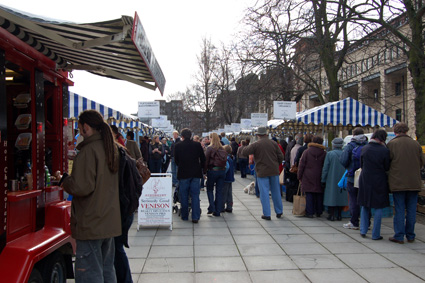
Edinburgh Farmers' Market
I'm a sucker for farmers' markets, if for no other reason than it helps me develop a feel for a place, in terms that I can understand. London's Borough Market shows a city that wants gourmet food, that wants an organic label, that wants the convenience of everything in one place. Its market exists in a specific place, a place that has no other purpose; it feels like a store. Those parts that are not currently useful, that will be selling something later, when its time comes, sit dark and empty.
In Edinburgh, the market sets up stalls along Castle Lane, in the shadow of Edinburgh Castle; it's temporary, small, and full almost to overflowing. Not just in terms of the shoppers, brushing past on the sidewalk, but in all of the stalls, as well. It's only as large as it has to be. There are no gaps. It's a local market, selling only what is available in season, which means plenty of meat at the end of March. Not just beef and pork - grass-fed, dry-aged beef; heritage pork breeds - but also wild game, which is impossible to find in the states.1 Wild venison, hare, wood pigeon, and plenty of others; it's probably best to keep alert for bird/buckshot lodged in the flesh, just in case.2 We also picked up some handmade chocolate truffles from Cocoa, full of interesting flavors like blackcurrant and pastis.
That week, all of the truffles had been made with Cuban chocolate. We'll never find that around here.
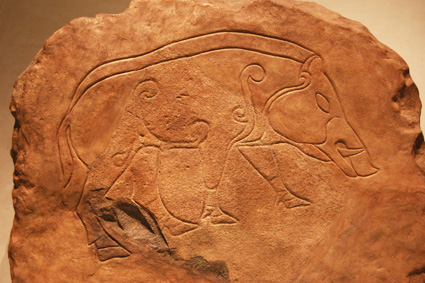
Prehistoric boar carving, Museum of Scotland
I also picked up a copy of The Scottish Farmers' Market Cookbook, by Nick Paul, who runs the Crisp Hut, making really nice potato chips with a variety of gourmet flavors. It's a recipe book, intended to get people to shop at their local markets, and has a couple of features that intrigue me:
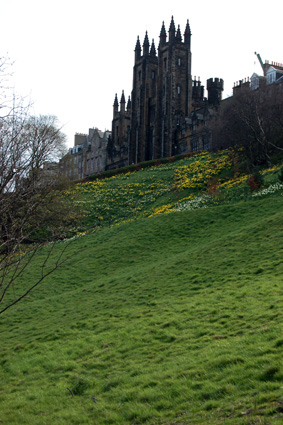
Princes Street Gardens and Old Town
Edinburgh, being in the UK, can be a real crapshoot when it comes to food. If you're willing to pony up some serious cash for one of the "Modern Scottish" restaurants - in general, places that are part of the emerging trend to focus on local, seasonal, and organic food, treated to bring out the natural flavors - you're probably safe, but cheap food tends to veer in the direction of deep-fried. Or little places, overbright with cold fluorescent lights, serving kebabs, burgers and pizza.5 And possibly something else entirely unrelated, like fish and chips.
So, where did we eat? A quite wonderful Thai restaurant, Songkran II, which was about twice as expensive as the places here in Madison, but the quality and presentation of the food were fantastic. My green curry - though noted as spicy on the menu, that was only in some bizarre British sense6 - was fullf of flavor, and well balanced; Sharon's orange chicken was not only lightly sauced - and not at all cloying, but just slightly sweet - but had a fantastically crisp skin. We also learned there that the Scots don't seem to go out to eat until 7:30pm or later, so we could get seats most anywhere as long as we were willing to eat early and not dawdle at the table.
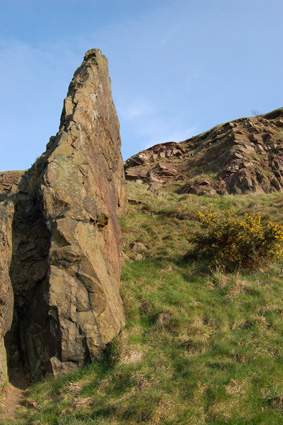
View from Radical Road
Another night was spent at David Bann, a trendy vegetarian place. The food was good, if sometimes a little unbalanced - wild mushroom and basil polenta; galette7 with adzuki beans and eggplant; watercress soup with purple sprouting broccoli and a poached egg; smoked tofu with stir-fried vegetables and sesame sauce; a dessert sampler for two, which included a pomegranate ice cream with redcurrant sauce - and well-presented, though the lighting was so dim that it was hard to tell. It also suffers from your typical European service, which is generally distant and brief. The same was true for La P'tite Folie, a little Breton cafe where we had lunch one day. The food was excellent - mussels in white wine and blue cheese; apple and brie in puff pastry; seared fish fillet with roast vegetables and mased potatoes; a lovely tartiflette - and we had a very pleasant bottle of Breton cider along with. But the staff was painfully French, living up to every snooty French stereotype we could imagine, except maybe chain-smoking.8 Ignore them, and it's a lunch spot well worth visiting.
Sharon also insisted that I have haggis while we were there, which is apparently a bigger deal for everyone who isn't me. Even a nice couple - British man, American woman - who sat with us at breakfast one morning, asked if we'd tried and if we knew what was in it. I didn't want to point out that I regularly keep assorted unusual (edible) animal parts in my freezer - they were eating breakfast, after all - but the notion of eating heart, liver and lungs doesn't much faze me. I even got Sharon to try a bite. She thought it was like Salisbury steak; it made me think of meatloaf with a slight offal flavor. Not the least bit offensive.
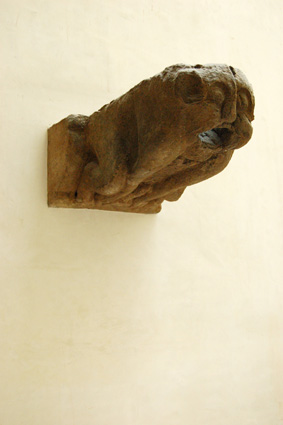
Gargoyle, Museum of Scotland
We ended up doing a little bit more of a tourist-type trip through Edinburgh, in part because we'd arrived in time for the weekend, and the warm, sunny weather seemed to bring everyone outside. Tops on the tourist circuit in Edinburgh? The Edinburgh Castle, though most everyone then funnels down the esplanade to poke into shops selling the usual pointless souvenirs based on broad ethnic and/or national stereotypes.
But, hey, we hadn't been suffering the ABCs,9 and we'd decided not to bother seeing the faux crown jewels in England. Edinburgh Castle has the real Scottish Honours on display, and though pictures are forbidden - though the guard was really quite nice to the two middle-aged women who didn't bother to notice any of the large signs - we figured it was worth it. I do have to say, though, that the tickets were really dull, and a disappointment after Greece. The Greeks may not have their act together in a variety of ways, but the tickets to their cultural attractions - from the Acropolis to the tiny little archaeological museum on Naxos - are genuinely lovely.
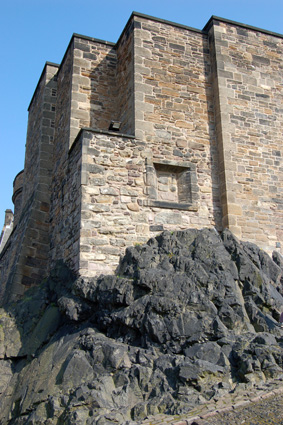
Edinburgh Castle atop rocky crags
So, it's a big castle, with the rigid geometry of manmade structures perched immediately atop the imposing, black rock. Sure, it's only black from the toxic air pollution of the Industrial Revolution and long years of coal stove exhaust, but it makes everything look even neater. The Honours are pretty enough, though I'll admit that the concept of royalty boggles my mind; and watching the crowds gather to watch the One O'Clock gun go off is pretty funny. It's a World War II-era artillery cannon that's fired at 1:00pm every day except Sunday, Christmas Day, and probably a handful of others. It goes boom; the crowds murmur about how loud it was; then they go back to taking pictures of themselves standing against the hilariously oversized cannon that is Mons Meg.
Also worthwhile, for a momentary detour, is St. Maragaret's Chapel. It's quite tiny, but the stained glass, up close, reminded me greatly of Stan Brakhage's hand-painted films. Not that it isn't impressive in a more traditional sense, but I was thrilled to find something - anything - in the real world that brought those films to mind.
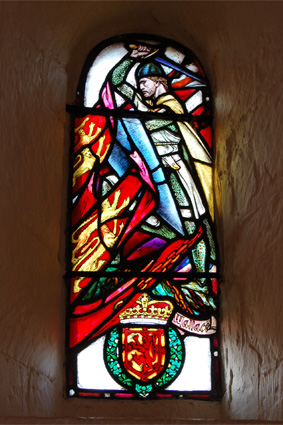
Stained glass, St. Margaret's Chapel
But it is very, very full of tourists. Many are quite kind about stepping out of the frame of your photographs - assuming you're kind enough to return the favor, of course - but it can be tough to make it look impressive in a photograph with a grumpy six-year old moping about. (He didn't like the hills and stairs, I gather.)
Fortunately, a visit to Calton Hill also requires enough climbing - not much, and none of it difficult - to keep half the hordes away. Located at the eastern end of New Town and Old Town, it offers some of the best easy-to-reach views of Edinburgh, as well as a cluster of monuments within spitting distance of each other: Robert Burns; Dugald Scott; Lord Horatio Nelson; and the Scottish National Monument, which is an intentional folly, not a project abandoned due to lack of funds, as the popular lore says.
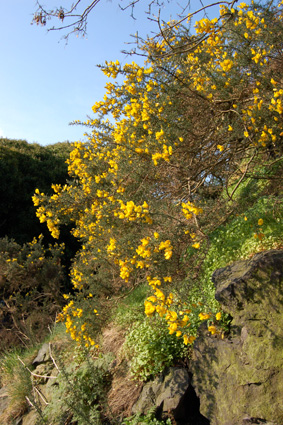
Flowers on Calton Hill
Should you want some even more impressive views, then it's worth heading over to Holyrood Park. A former hunting ground for the Scottish king, it's a massive park surrounded by the city. Arthur's Seat, at the center, isn't quite a mountain, but it is the highest point in Edinburgh, and enough of a climb to thin out the crowds considerably. The peak isn't large, though, and folks tend to linger, but you can enjoy the rest of the park in relative solitude.
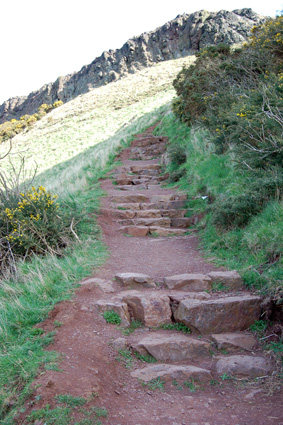
Stair to Arthur's Seat
But as impressive as the view is, it somehow feels separated from the city, even though it surrounds you on all sides. The park is so large that, no matter in which direction you look, it's almost as if you're looking upon Edinburgh from afar.
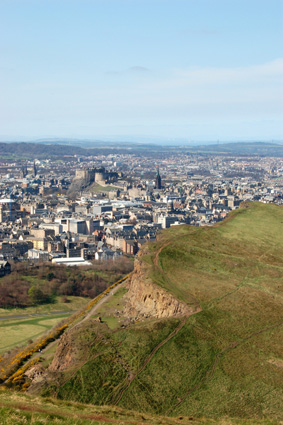
Edinburgh from Arthur's Seat
Should climbs not be your thing, the park still offers a wealth of meandering paths through Holyrood Park that can easily eat up an afternoon or more. It's an especially popular place for people with dogs - off the leash, there's no end to the possibilities for rooting about and smelling things - and looking up at Arthur's Seat and the Salisbury Crags from the valley between is nearly as lovely a picture as being up high. Though most of the wild animals that once made it a favored hunting ground are long gone - save for the swans, geese, and various species of ducks paddling about the lochs - it's perhaps the most pleasant city park I've seen in a long time. Maybe ever.

Salisbury Crags above Radical Road
The views from Salisbury Crags are definitely the best in the park, and from the top - a steep, trailless climb from the north end of Radical Road - you can experience them with almost no one else to bother you. When the ground drops away in nearly vertical, ragged rock faces, you can almost imagine that you're standing immediately atop the city. It's also one of the best places to get a good look at the new Scottish Parliament.
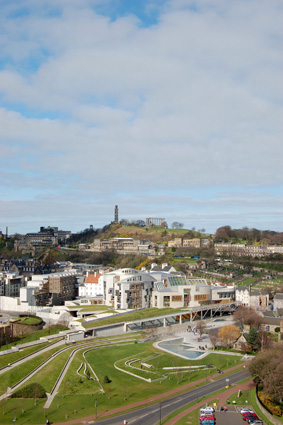
Scottish Parliament Building and Calton Hill
It's controversial, due to the collision of a variety of factors: it's architecturally daring; it ran well over budget; construction took far longer than originally estimated; the design architect, Enric Miralles, died suddenly shortly after construction started; and the man responsible for selecting Miralles' design, who was essentially the owner's representative, also died before the project was completed. It's the sort of building that tends to inspire strong feelings, especially in a city that's not overwhelmed with modern architecture.

Scottish Parliament Building
I think it's interesting, even if some of it's a little clunky. We didn't have a chance to see any of the interior, and I'm not sure how well it actually functions, but at least it's got a genuinely unique character. Even if Miralles did seem to be a fan of heavy-handed - if obtuse - symbolism. You know he was definitely using certain elements to make specific statements, but sometimes it's hard to tell what, exactly, he was trying to say. The fact that he didn't live to explain any of it doesn't help.
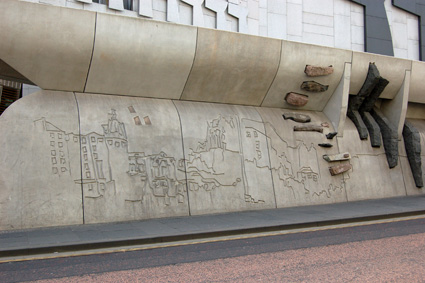
Scottish Parliament Building
Some of it works, though. The north wall features stones from all over Scotland, quotes from famous Scottish writers, and a large engraving made from a sketch Miralles made of Edinburgh during one of his visits. It's impossible to miss, at the end of the Royal Mile, and it's an irregular enough execution of a not-so-unusual concept to grab attention without being confusing.
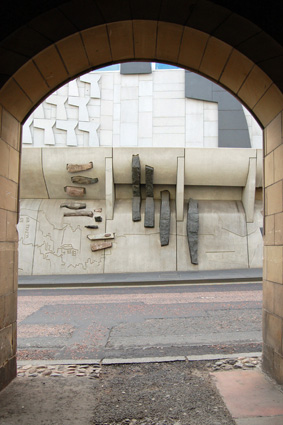
Scottish Parliament Building
The other modernist culture center in Edinburgh is the Museum of Scotland, which traces the history of the people who've lived in Scotland - and some of the non-people residents - from prehistory through the 20th century. I think. We didn't make it all of the way through; even devoting a full day is nowhere near enough time to give even a cursory pass through it all. We only got as far as the beginnings of the Industrial Revolution.
Part of the reason was that I was distracted by the installation works of Scottish artist Andy Goldsworthy on display amidst the prehistoric exhibits.

Clay wall sculpture, Andy Goldsworthy, Museum of Scotland
Andy Goldsworthy's works fall into two general categories: ephemeral art and installation art. All of his work is about expressing the qualities - often in non-intuitive ways - of natural materials, and of the effect that time and natural forces have on those materials. A sense of place, like terroir, is crucial; as a rule, just about everything he creates is going to fall apart. That's part of its life cycle. There are no unnatural elements - hidden structural supports or mortar keeping the stones in a wall fixed together. For his ephemeral works, which are usually made without the use of tools, the span of its existence is brief, and can even be as short as seconds. The installation pieces are more permanent, and though they may have been made with modern tools and skilled labor, they, too, will eventually be broken down by natural forces.
He has several clay walls at the museum, with images formed in the cracks as the clay dries. The clay came from nearby Dumfriesshire; the hair binding it, though it wasn't noted, is likely from a Scottish barber shop. The images formed on the surface are caused by forming structure behind the clay, which affects its rate of drying and creates the images.

Slate wall sculpture, Andy Goldsworthy, Museum of Scotland
A circle of slate walls surrounds a group of exhibits, at least eight feet tall, composed of small, stacked sheets of stone. In the centers of these four walls - it's divided into quadrants to let people in and out - are circles, at least two feet in diameter, where the slate has been aligned in other directions, like vertical or diagonal. The sheer labor that went into it, layering all of those pieces without any mortar to bind, is impressive.
Nearby is a small cairn, composed of bleached whale bones collected from Scottish beaches. It's a miniature version of Goldsworthy's typical cairns - often of an area's local stone, though he's built them of other materials, including sheets of river ice - and like an abstraction of the coastal middens of the prehistoric peoples, the refuse heaps of mussel shells and such that prove humans have been enjoying seafood buffets on the beach for thousands of years.
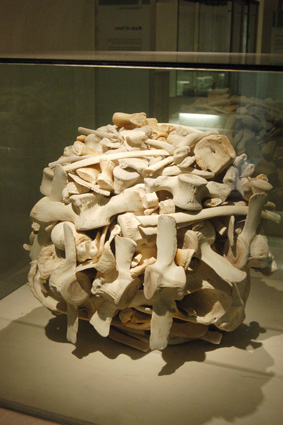
Whale bone cairn sculpture, Andy Goldsworthy, Museum of Scotland
And, once you've had enough of the walking and climbing and museum-going, you can do as we did, relaxing on the benches in the Princes Street Gardens, reveling in the carpet of daffodils signalling the arrival of spring.
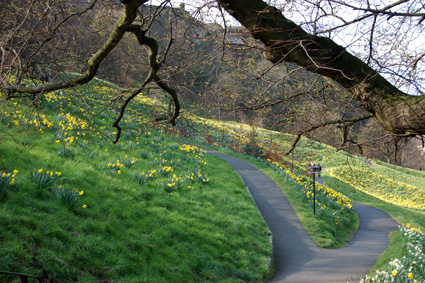
Princes Street Gardens
* * * * *
1The USDA does not permit the sale of legally hunted wild animals, at least not those hunted in the US. If you see anything labeled as "wild" in a restaurant, then it's most likely the breed name, but raised domestically and slaughtered in an inspected slaughterhouse. Wild boar, for example, is just the name of the breed. Sometimes, restaurants will serve actual wild game; much of that comes from Scotland, where the sale of hunted animals is legal, and they're legal for sale here, too.
2Seriously.
3I now regret that I tossed it, but I had clipped a chart of seasonal availability for popular fruits and vegetables from the Chicago Tribune a few years ago. It was a horizontal sort of bar graph, brightly colored, quick to read and intuitive. One of these days, when I've settled down and grown comfortable with the markets around my home, I plan to create one for myself. Hey, Thomas Jefferson spent years noting the arrivals of new produce in the markets; if you want to eat with the seasons, it can't hurt to do a little legwork.
4Though a good number of the recipes in Jane Grigson's English Food - which I'd borrowed from Melissa while traveling, and read cover to cover - certainly are. Copious amounts of cream; a tendency to overcook, or occasionally undercook perfectly good vegetables; puddings, cakes, and other desserts with alarming quantities of sugar; and, in perhaps the most egregious culinary crime in the book, "Isle of Man Salt Duck", an entire duck is carefully given a light salt cure, then boiled. Boiled. Ignoring that most glorious possibility of duck: the crispy, crunchy skin. In Grigson's defense, though, I think it's an excellent survey of authentic British food, as far as culinary authenticity can go, and I plan on purchasing a copy for myself. It's not a collection of her recipes, but rather classic English ones, and she's good about pointing out that the British have the unfortunate habit of choosing bad food over good. Their reputation of having the world's worst food, while perhaps unfair, isn't coming entirely out of left field. And she finds evidence that the observation of awful British teeth goes back centuries, apparently.
5Maybe things have changed since my time in Brighton and Leeds, but as far as I'm concerned, British pizza is an abomination, a crime against both man and nature. German pizza, too. Likewise, Sharon doesn't have much that's positive to say about Japanese pizza.
6We joke about "Midwest Hot" as pretty mild compared to "East/West Coast Hot" here in Madison, at least with the other folks from places near oceans. (Though, occasionally, you'll find a place that'll do something akin to authentic Thai/Lao/Vietnamese levels of spiciness.) But "British Hot" makes "Midwest Hot" look downright sinus-clearing, as near as I can tell.
7Except that it was in crepes, not a galette. Sharon really liked it, but I felt that the mint in it was about as subtle as a hammer to the head.
8Edinburgh, like Madison, is a non-smoking town, and it's such a relief not to feel like you need a shower after you've been out for dinner or a drink.
9Another Bloody Church, Another Bloody Castle.

Arthur's Seat from Calton Hill
If there was one thing we hadn't expected to find it Scotland, it was sunny days. The sort of sun that counteracts the brisk chill of the wind. But, save for our last morning, we had skies only lightly scattered with clouds, leading us to spend our spare moments, of which we had many, slowly wandering the streets and parks of Edinburgh.
We hadn't planned but the littlest bit of our trip to Edinburgh until we had boarded the plane to leave Greece. We weren't even sure that we would spend all of our time there, and skimmed the guidebook for ideas. The city has no shortage of museums - many with similar enough names that we continually had to check the guidebook to ensure we were headed to the intended place - and is full of pleasant parks, ranging in size from miniature grassy plots to the massive Holyrood Park, with its lochs, crags and towering hills. But, as we looked through the recommendations for shopping - still needed a few souvenirs - we spotted a note about the Edinburgh Farmers' Market. It just happened to take place on Saturday morning, and made for an ideal introduction to the city.

Edinburgh Farmers' Market
I'm a sucker for farmers' markets, if for no other reason than it helps me develop a feel for a place, in terms that I can understand. London's Borough Market shows a city that wants gourmet food, that wants an organic label, that wants the convenience of everything in one place. Its market exists in a specific place, a place that has no other purpose; it feels like a store. Those parts that are not currently useful, that will be selling something later, when its time comes, sit dark and empty.
In Edinburgh, the market sets up stalls along Castle Lane, in the shadow of Edinburgh Castle; it's temporary, small, and full almost to overflowing. Not just in terms of the shoppers, brushing past on the sidewalk, but in all of the stalls, as well. It's only as large as it has to be. There are no gaps. It's a local market, selling only what is available in season, which means plenty of meat at the end of March. Not just beef and pork - grass-fed, dry-aged beef; heritage pork breeds - but also wild game, which is impossible to find in the states.1 Wild venison, hare, wood pigeon, and plenty of others; it's probably best to keep alert for bird/buckshot lodged in the flesh, just in case.2 We also picked up some handmade chocolate truffles from Cocoa, full of interesting flavors like blackcurrant and pastis.
That week, all of the truffles had been made with Cuban chocolate. We'll never find that around here.

Prehistoric boar carving, Museum of Scotland
I also picked up a copy of The Scottish Farmers' Market Cookbook, by Nick Paul, who runs the Crisp Hut, making really nice potato chips with a variety of gourmet flavors. It's a recipe book, intended to get people to shop at their local markets, and has a couple of features that intrigue me:
- A directory of producers. Organized into categories of products, it lists producers attending a majority of the farmers' markets throughout Scotland, and includes contact information for all of them.
- Market dates and locations, including websites for information that may have changed since publication. It seems that most of the markets in Scotland operate on Saturdays, often only once per month.
- A list of peak seasonal availability of fruits and vegetables.3 If you're attempting to eat seasonally and locally, but prefer to cook from recipes, I'd imagine it's quite helpful to have this sort of reference.

Princes Street Gardens and Old Town
Edinburgh, being in the UK, can be a real crapshoot when it comes to food. If you're willing to pony up some serious cash for one of the "Modern Scottish" restaurants - in general, places that are part of the emerging trend to focus on local, seasonal, and organic food, treated to bring out the natural flavors - you're probably safe, but cheap food tends to veer in the direction of deep-fried. Or little places, overbright with cold fluorescent lights, serving kebabs, burgers and pizza.5 And possibly something else entirely unrelated, like fish and chips.
So, where did we eat? A quite wonderful Thai restaurant, Songkran II, which was about twice as expensive as the places here in Madison, but the quality and presentation of the food were fantastic. My green curry - though noted as spicy on the menu, that was only in some bizarre British sense6 - was fullf of flavor, and well balanced; Sharon's orange chicken was not only lightly sauced - and not at all cloying, but just slightly sweet - but had a fantastically crisp skin. We also learned there that the Scots don't seem to go out to eat until 7:30pm or later, so we could get seats most anywhere as long as we were willing to eat early and not dawdle at the table.

View from Radical Road
Another night was spent at David Bann, a trendy vegetarian place. The food was good, if sometimes a little unbalanced - wild mushroom and basil polenta; galette7 with adzuki beans and eggplant; watercress soup with purple sprouting broccoli and a poached egg; smoked tofu with stir-fried vegetables and sesame sauce; a dessert sampler for two, which included a pomegranate ice cream with redcurrant sauce - and well-presented, though the lighting was so dim that it was hard to tell. It also suffers from your typical European service, which is generally distant and brief. The same was true for La P'tite Folie, a little Breton cafe where we had lunch one day. The food was excellent - mussels in white wine and blue cheese; apple and brie in puff pastry; seared fish fillet with roast vegetables and mased potatoes; a lovely tartiflette - and we had a very pleasant bottle of Breton cider along with. But the staff was painfully French, living up to every snooty French stereotype we could imagine, except maybe chain-smoking.8 Ignore them, and it's a lunch spot well worth visiting.
Sharon also insisted that I have haggis while we were there, which is apparently a bigger deal for everyone who isn't me. Even a nice couple - British man, American woman - who sat with us at breakfast one morning, asked if we'd tried and if we knew what was in it. I didn't want to point out that I regularly keep assorted unusual (edible) animal parts in my freezer - they were eating breakfast, after all - but the notion of eating heart, liver and lungs doesn't much faze me. I even got Sharon to try a bite. She thought it was like Salisbury steak; it made me think of meatloaf with a slight offal flavor. Not the least bit offensive.

Gargoyle, Museum of Scotland
We ended up doing a little bit more of a tourist-type trip through Edinburgh, in part because we'd arrived in time for the weekend, and the warm, sunny weather seemed to bring everyone outside. Tops on the tourist circuit in Edinburgh? The Edinburgh Castle, though most everyone then funnels down the esplanade to poke into shops selling the usual pointless souvenirs based on broad ethnic and/or national stereotypes.
But, hey, we hadn't been suffering the ABCs,9 and we'd decided not to bother seeing the faux crown jewels in England. Edinburgh Castle has the real Scottish Honours on display, and though pictures are forbidden - though the guard was really quite nice to the two middle-aged women who didn't bother to notice any of the large signs - we figured it was worth it. I do have to say, though, that the tickets were really dull, and a disappointment after Greece. The Greeks may not have their act together in a variety of ways, but the tickets to their cultural attractions - from the Acropolis to the tiny little archaeological museum on Naxos - are genuinely lovely.

Edinburgh Castle atop rocky crags
So, it's a big castle, with the rigid geometry of manmade structures perched immediately atop the imposing, black rock. Sure, it's only black from the toxic air pollution of the Industrial Revolution and long years of coal stove exhaust, but it makes everything look even neater. The Honours are pretty enough, though I'll admit that the concept of royalty boggles my mind; and watching the crowds gather to watch the One O'Clock gun go off is pretty funny. It's a World War II-era artillery cannon that's fired at 1:00pm every day except Sunday, Christmas Day, and probably a handful of others. It goes boom; the crowds murmur about how loud it was; then they go back to taking pictures of themselves standing against the hilariously oversized cannon that is Mons Meg.
Also worthwhile, for a momentary detour, is St. Maragaret's Chapel. It's quite tiny, but the stained glass, up close, reminded me greatly of Stan Brakhage's hand-painted films. Not that it isn't impressive in a more traditional sense, but I was thrilled to find something - anything - in the real world that brought those films to mind.

Stained glass, St. Margaret's Chapel
But it is very, very full of tourists. Many are quite kind about stepping out of the frame of your photographs - assuming you're kind enough to return the favor, of course - but it can be tough to make it look impressive in a photograph with a grumpy six-year old moping about. (He didn't like the hills and stairs, I gather.)
Fortunately, a visit to Calton Hill also requires enough climbing - not much, and none of it difficult - to keep half the hordes away. Located at the eastern end of New Town and Old Town, it offers some of the best easy-to-reach views of Edinburgh, as well as a cluster of monuments within spitting distance of each other: Robert Burns; Dugald Scott; Lord Horatio Nelson; and the Scottish National Monument, which is an intentional folly, not a project abandoned due to lack of funds, as the popular lore says.

Flowers on Calton Hill
Should you want some even more impressive views, then it's worth heading over to Holyrood Park. A former hunting ground for the Scottish king, it's a massive park surrounded by the city. Arthur's Seat, at the center, isn't quite a mountain, but it is the highest point in Edinburgh, and enough of a climb to thin out the crowds considerably. The peak isn't large, though, and folks tend to linger, but you can enjoy the rest of the park in relative solitude.

Stair to Arthur's Seat
But as impressive as the view is, it somehow feels separated from the city, even though it surrounds you on all sides. The park is so large that, no matter in which direction you look, it's almost as if you're looking upon Edinburgh from afar.

Edinburgh from Arthur's Seat
Should climbs not be your thing, the park still offers a wealth of meandering paths through Holyrood Park that can easily eat up an afternoon or more. It's an especially popular place for people with dogs - off the leash, there's no end to the possibilities for rooting about and smelling things - and looking up at Arthur's Seat and the Salisbury Crags from the valley between is nearly as lovely a picture as being up high. Though most of the wild animals that once made it a favored hunting ground are long gone - save for the swans, geese, and various species of ducks paddling about the lochs - it's perhaps the most pleasant city park I've seen in a long time. Maybe ever.

Salisbury Crags above Radical Road
The views from Salisbury Crags are definitely the best in the park, and from the top - a steep, trailless climb from the north end of Radical Road - you can experience them with almost no one else to bother you. When the ground drops away in nearly vertical, ragged rock faces, you can almost imagine that you're standing immediately atop the city. It's also one of the best places to get a good look at the new Scottish Parliament.

Scottish Parliament Building and Calton Hill
It's controversial, due to the collision of a variety of factors: it's architecturally daring; it ran well over budget; construction took far longer than originally estimated; the design architect, Enric Miralles, died suddenly shortly after construction started; and the man responsible for selecting Miralles' design, who was essentially the owner's representative, also died before the project was completed. It's the sort of building that tends to inspire strong feelings, especially in a city that's not overwhelmed with modern architecture.

Scottish Parliament Building
I think it's interesting, even if some of it's a little clunky. We didn't have a chance to see any of the interior, and I'm not sure how well it actually functions, but at least it's got a genuinely unique character. Even if Miralles did seem to be a fan of heavy-handed - if obtuse - symbolism. You know he was definitely using certain elements to make specific statements, but sometimes it's hard to tell what, exactly, he was trying to say. The fact that he didn't live to explain any of it doesn't help.

Scottish Parliament Building
Some of it works, though. The north wall features stones from all over Scotland, quotes from famous Scottish writers, and a large engraving made from a sketch Miralles made of Edinburgh during one of his visits. It's impossible to miss, at the end of the Royal Mile, and it's an irregular enough execution of a not-so-unusual concept to grab attention without being confusing.

Scottish Parliament Building
The other modernist culture center in Edinburgh is the Museum of Scotland, which traces the history of the people who've lived in Scotland - and some of the non-people residents - from prehistory through the 20th century. I think. We didn't make it all of the way through; even devoting a full day is nowhere near enough time to give even a cursory pass through it all. We only got as far as the beginnings of the Industrial Revolution.
Part of the reason was that I was distracted by the installation works of Scottish artist Andy Goldsworthy on display amidst the prehistoric exhibits.

Clay wall sculpture, Andy Goldsworthy, Museum of Scotland
Andy Goldsworthy's works fall into two general categories: ephemeral art and installation art. All of his work is about expressing the qualities - often in non-intuitive ways - of natural materials, and of the effect that time and natural forces have on those materials. A sense of place, like terroir, is crucial; as a rule, just about everything he creates is going to fall apart. That's part of its life cycle. There are no unnatural elements - hidden structural supports or mortar keeping the stones in a wall fixed together. For his ephemeral works, which are usually made without the use of tools, the span of its existence is brief, and can even be as short as seconds. The installation pieces are more permanent, and though they may have been made with modern tools and skilled labor, they, too, will eventually be broken down by natural forces.
He has several clay walls at the museum, with images formed in the cracks as the clay dries. The clay came from nearby Dumfriesshire; the hair binding it, though it wasn't noted, is likely from a Scottish barber shop. The images formed on the surface are caused by forming structure behind the clay, which affects its rate of drying and creates the images.

Slate wall sculpture, Andy Goldsworthy, Museum of Scotland
A circle of slate walls surrounds a group of exhibits, at least eight feet tall, composed of small, stacked sheets of stone. In the centers of these four walls - it's divided into quadrants to let people in and out - are circles, at least two feet in diameter, where the slate has been aligned in other directions, like vertical or diagonal. The sheer labor that went into it, layering all of those pieces without any mortar to bind, is impressive.
Nearby is a small cairn, composed of bleached whale bones collected from Scottish beaches. It's a miniature version of Goldsworthy's typical cairns - often of an area's local stone, though he's built them of other materials, including sheets of river ice - and like an abstraction of the coastal middens of the prehistoric peoples, the refuse heaps of mussel shells and such that prove humans have been enjoying seafood buffets on the beach for thousands of years.

Whale bone cairn sculpture, Andy Goldsworthy, Museum of Scotland
And, once you've had enough of the walking and climbing and museum-going, you can do as we did, relaxing on the benches in the Princes Street Gardens, reveling in the carpet of daffodils signalling the arrival of spring.

Princes Street Gardens
* * * * *
1The USDA does not permit the sale of legally hunted wild animals, at least not those hunted in the US. If you see anything labeled as "wild" in a restaurant, then it's most likely the breed name, but raised domestically and slaughtered in an inspected slaughterhouse. Wild boar, for example, is just the name of the breed. Sometimes, restaurants will serve actual wild game; much of that comes from Scotland, where the sale of hunted animals is legal, and they're legal for sale here, too.
2Seriously.
3I now regret that I tossed it, but I had clipped a chart of seasonal availability for popular fruits and vegetables from the Chicago Tribune a few years ago. It was a horizontal sort of bar graph, brightly colored, quick to read and intuitive. One of these days, when I've settled down and grown comfortable with the markets around my home, I plan to create one for myself. Hey, Thomas Jefferson spent years noting the arrivals of new produce in the markets; if you want to eat with the seasons, it can't hurt to do a little legwork.
4Though a good number of the recipes in Jane Grigson's English Food - which I'd borrowed from Melissa while traveling, and read cover to cover - certainly are. Copious amounts of cream; a tendency to overcook, or occasionally undercook perfectly good vegetables; puddings, cakes, and other desserts with alarming quantities of sugar; and, in perhaps the most egregious culinary crime in the book, "Isle of Man Salt Duck", an entire duck is carefully given a light salt cure, then boiled. Boiled. Ignoring that most glorious possibility of duck: the crispy, crunchy skin. In Grigson's defense, though, I think it's an excellent survey of authentic British food, as far as culinary authenticity can go, and I plan on purchasing a copy for myself. It's not a collection of her recipes, but rather classic English ones, and she's good about pointing out that the British have the unfortunate habit of choosing bad food over good. Their reputation of having the world's worst food, while perhaps unfair, isn't coming entirely out of left field. And she finds evidence that the observation of awful British teeth goes back centuries, apparently.
5Maybe things have changed since my time in Brighton and Leeds, but as far as I'm concerned, British pizza is an abomination, a crime against both man and nature. German pizza, too. Likewise, Sharon doesn't have much that's positive to say about Japanese pizza.
6We joke about "Midwest Hot" as pretty mild compared to "East/West Coast Hot" here in Madison, at least with the other folks from places near oceans. (Though, occasionally, you'll find a place that'll do something akin to authentic Thai/Lao/Vietnamese levels of spiciness.) But "British Hot" makes "Midwest Hot" look downright sinus-clearing, as near as I can tell.
7Except that it was in crepes, not a galette. Sharon really liked it, but I felt that the mint in it was about as subtle as a hammer to the head.
8Edinburgh, like Madison, is a non-smoking town, and it's such a relief not to feel like you need a shower after you've been out for dinner or a drink.
9Another Bloody Church, Another Bloody Castle.
Subscribe to:
Posts (Atom)
